Physical Address
304 North Cardinal St.
Dorchester Center, MA 02124
Box 20-1 contains the classification of neoplasms of the salivary glands.
Pleomorphic adenoma
Basal cell adenoma
Canalicular adenoma
Warthin tumor
Myoepithelioma
Oncocytoma
Sclerosing polycystic adenosis
Cystadenoma
Ductal papillomas:
Sialadenoma papilliferum
Inverted ductal papilloma
Intraductal papilloma
Other uncommon adenomas
Striated duct adenoma
Intercalated duct adenoma
Lymphadenoma (nonsebaceous)
Keratocystoma
Lipoadenoma
Apocrine adenoma
Adenofibroma
Tumors with sebaceous differentiation
Sebaceous adenoma
Sebaceous lymphadenoma
Salivary gland anlage tumor
Hemangioma
Neurilemmoma/neurofibroma
Lipoma
Others
Mucoepidermoid carcinoma
Acinic cell adenocarcinoma
Mammary analogue secretory carcinoma
Adenocarcinoma, NOS
Adenoid cystic carcinoma
Polymorphous low-grade adenocarcinoma
Carcinoma ex pleomorphic adenoma
Invasive
Intracapsular
Carcinosarcoma
Metastasizing pleomorphic adenoma
Basal cell adenocarcinoma
Epithelial-myoepithelial carcinoma
Clear cell adenocarcinoma; Hyalinizing clear cell carcinoma
Cystadenocarcinoma
Myoepithelial carcinoma
Salivary duct carcinoma
Intraductal carcinoma (low-grade cribriform cystadenocarcinoma; low-grade salivary duct carcinoma)
Squamous cell carcinoma
Adenosquamous carcinoma
Lymphoepithelial carcinoma
Neuroendocrine carcinomas
Undifferentiated (large-cell) carcinoma
Oncocytic carcinoma
Mucinous adenocarcinoma
Cribriform adenocarcinoma of minor salivary glands (CAMSG)
Sebaceous carcinoma/lymphadenocarcinoma
Sialoblastoma
Hematolymphoid
Non-Hodgkin lymphoma
Hodgkin lymphoma
Sarcomas
Secondary Neoplasms
Salivary gland neoplasms account for between 2% and 6.5% of all neoplasms of the head and neck.
Demographics vary per tumor type, but in general salivary gland neoplasm are:
More common in women than in men
Occur in all age groups, including children, but with a peak incidence in sixth to seventh decades of life
Majority of salivary gland neoplasms occur in parotid gland
Majority of salivary gland neoplasms are of epithelial origin, representing 80% to 90% of all neoplasms
Benign neoplasms represent approximately 75% of all salivary gland neoplasms:
Most common benign neoplasm is pleomorphic adenoma
Among malignant tumors, mucoepidermoid carcinoma is most common:
True for adult and pediatric ages
Mesenchymal neoplasms of salivary glands are rare:
Exception is in infants
Hemangioma and lymphangioma most common
Sialoblastoma and salivary gland anlage tumors occur almost exclusively in newborns and infants.
As compared with neoplasms of major salivary glands, in which benign neoplasms represent the greater proportion of tumors, relative to minor salivary glands a greater proportion of neoplasms are malignant.
Tumor types vary per gland involved
Some examples of tumors primarily (but not exclusively) occurring in major salivary glands include:
Warthin tumor
Basal cell adenoma
Oncocytoma
Acinic cell carcinoma
Mammary analogue secretory carcinoma
Basal cell adenocarcinoma
Epithelial-myoepithelial carcinoma
Carcinoma ex pleomorphic adenoma
Salivary duct carcinoma
Oncocytic carcinoma
Some examples of tumors primarily (but not exclusively) occurring in minor salivary glands include:
Canalicular adenoma (lip)
Ductal papillomas (lip, oral cavity)
Cystadenoma
Polymorphous low-grade adenocarcinoma (intraoral minor salivary glands)
Cribriform adenocarcinoma of minor salivary glands (tongue, oral cavity)
Cystadenocarcinoma
Features associated with major versus minor salivary glands:
Major salivary gland neoplasms:
All are encapsulated.
Invasion beyond the capsule generally is diagnostic for malignancy.
Extension into the capsule does not represent invasion.
Invasion includes lesional cells into adjacent salivary gland parenchyma, perineural invasion, lymph-vascular invasion, invasion into connective tissues.
Rare exceptions to the above include:
Lymph-vascular permeation in pleomorphic adenomas
Metastatic pleomorphic adenoma
Several malignant salivary gland neoplasms may be encapsulated or noninvasive, including:
Mucoepidermoid carcinoma
Acinic cell carcinoma
Adenoid cystic carcinoma
Carcinoma ex pleomorphic adenoma (CEPA)
Epithelial-myoepithelial carcinoma
Mammary analogue secretory carcinoma
Except for CEPA, above list of malignant neoplasms has no known benign counterparts, so once requisite diagnostic criteria are established, a diagnosis can be rendered in the absence of invasion
Minor salivary gland neoplasms:
All are unencapsulated.
More common tumor types include pleomorphic adenoma, polymorphous low-grade adenocarcinoma and adenoid cystic carcinoma share growth patterns, cytomorphology, cell composition and immunohistochemical reactivity such that differentiation is predicated on presence or absence of invasion (e.g., neurotropism, LVI, soft tissue, bone)
Generalizations relative to salivary gland neoplasms:
Growth patterns:
ALL salivary gland neoplasms are polymorphic (i.e., more than one growth pattern).
Polymorphic growth does not equate to any specific diagnosis (e.g., polymorphous low-grade adenocarcinoma).
Cytomorphology:
Some benign (e.g., pleomorphic adenoma) and some histologically low-grade malignant salivary gland neoplasms (e.g., polymorphous low-grade adenocarcinoma, adenoid cystic carcinoma) may be composed of similar isomorphic cell type(s) lacking significant nuclear pleomorphism, increased mitotic activity.
Dual cell composition:
Many benign and malignant neoplasms composed of admixture of epithelial cells and myoepithelial cells as identified by:
Light microscopy
Immunohistochemical staining (cytokeratins, p63, p40, calponin, S100 protein, SMA, and/or GFAP)
Given above overlapping features between some benign and some malignant salivary gland neoplasms, in limited biopsies especially those including tissue fragments composed entirely or near entirely of lesional cells without surrounding tissue to evaluate for invasion, differentiation often cannot be achieved and a diagnosis of “salivary gland neoplasm, not further specified” is advised with the recommendation for conservative but complete excision.
Risk factors linked to the development of salivary gland neoplasia include:
Radiation exposure
Familial or genetic predisposition
Tobacco use:
Strong association between tobacco use and the development of Warthin tumor
Microorganisms:
Epstein-Barr virus linked to lymphoepithelial carcinoma
Exposure to industrial chemicals
Similar to the thyroid gland, fine-needle aspiration biopsy (FNAB) represents the initial diagnostic modality in assessing the pathology of a salivary gland mass; FNAB is:
Cost effective and efficient
Has a sensitivity rate reported to be 81% to 98%
Has a specificity rate reported to be 60% to 75%
Has a false negative rate reported to be 5% to 10%:
Cytologically diagnosed as malignant but histologically proven to be benign
Has a false positive rate reported to be 0% to 6%:
Cytologically diagnosed as malignant and histologically proven to be benign
Those tumors in which the FNAB diagnosis is equivocal or inconclusive likely result in intraoperative consultation (i.e., frozen section analysis) to clarify and/or confirm the diagnosis (see Chapter 21 for the intraoperative diagnoses of salivary gland tumors).
In general, the light microscopic features of salivary gland neoplasms are distinctive so that use of immunohistochemistry is not necessarily required to arrive at a diagnosis; however, exceptions to this rule exist and immunohistochemical analysis may be required in the diagnosis and differential diagnosis of salivary gland neoplasms:
Immunohistochemical antigenic profile of salivary gland neoplasms often correlates to the histogenetic derivation of the tumor.
Tumors derived from the distal segments of the salivary duct system (intercalated ducts and acini) may take origin from a combination of epithelial and myoepithelial cells and may have different and diagnostic immunoreactivity as compared with those neoplasms that originate from more proximal segments of the duct system (striated and excretory ducts) in which myoepithelial cells are absent.
Some neoplasms have relatively unique markers or combination of markers, including (but not limited to):
DOG1 immunoreactivity in acinic cell carcinoma
Diffuse and strong mammaglobin and S100 protein staining in mammary analogue secretory carcinoma
Androgen receptor and salivary duct carcinoma
However, there is substantial overlap in the immunohistochemical antigenic profile among a wide variety of tumor types such that differentiating cannot be determined by immunohistochemical staining alone.
Immunohistochemical findings of selected salivary gland neoplasms are detailed in Table 20-1 .
| Tumor | PanK | LMWK | HMWK | p63 | p40 | S100 | DOG-1 | MGB | AR | GATA-3 | Her-2 | CD117 | PLAG1 |
|---|---|---|---|---|---|---|---|---|---|---|---|---|---|
| PA | + | + | + | + | + | + | − | − | − | v | − | v | + |
| BCA/BCAdC | + | + | + | + | + | + | − | − | − | v | − | v | v |
| MYO | + | + | + | + | + | + | − | − | − | v | − | v | + |
| MEC | + | + | + | + | + | − | − | − | − | v | − | v | − |
| ACC | + | + | + | − | − | − | + | − | − | − | − | − | − |
| MASC | + | + | + | − | − | + | − | + | − | + (n) | − | − | − |
| AdCC | + | + | + | + | + | + | + † | − | − | − | − | + (lum) | − |
| PLGA | + | + | + | + | − | + | − | − | − | − | − | v | v |
| SDC | + | + | + | − | − | − | − | − | + (n) | + (n) | v (memb) | − | − |
| EMC | + | + | + | + | + | + | + † | − | − | − | − | − | − |
| CCC/HCCC | +/+ | +/+ | +/+ | −/+ | − | −/− | −/− | −/− | −/− | −/− | −/− | −/− | −/− |
* Staining characteristics vary widely among tumor types and even within the same tumor type. This table details ideal staining characteristics per tumor type, and although these staining patterns generally remain consistent, any given tumor listed may defy “convention” and show reactivity for a marker usually not associated with that tumor or may lack a marker usually associated with that tumor (e.g., p63 in myoepithelial cells).
† Frequently positive often showing distinctive combined apical ductal and membranous/cytoplasmic myoepithelial staining profile.
SRY-related HMG-box 10 (Sox10) protein:
Transcription factor crucial in development of neural crest, Schwann cells, and melanocytes
Positive expression found in major salivary gland
Sox10 expression in salivary gland neoplasms reported as:
Positive in acinic cell carcinoma, adenoid cystic carcinoma, epithelial-myoepithelial carcinoma, myoepithelial carcinoma, pleomorphic adenoma, and carcinoma ex pleomorphic adenoma:
Sox10 expression specific to nuclei of acini, luminal, and abluminal cells of intercalated ducts but not in other sites
Negative in salivary duct carcinomas, mucoepidermoid carcinomas, oncocytic carcinoma, oncocytomas, and Warthin tumor
In other organ sites (e.g., breast, prostate, other) the identification of two cell types (e.g., ductal and myoepithelial or basal cells) may correlate to a benign neoplasm, whereas the presence of a single cell type may correlate to an adenocarcinoma; these criteria are not necessarily applicable to salivary gland, in that there are benign neoplasms composed of only a single cell type (e.g., monomorphic adenomas) and malignant tumors composed of dual cell types (e.g., adenoid cystic carcinoma, epithelial-myoepithelial carcinoma, others).
Cytogenetics and molecular genetics ( Table 20-2 ):
Recent studies have identified genes correlating to specific tumor types, which can be used as adjuncts to light microscopic and immunohistochemical staining in diagnosis and differential diagnosis.
| Tumor | Chromosomal Translocation | Gene Fusion | Percentage of Cases |
|---|---|---|---|
| Pleomorphic adenoma | Rearrangement of 8q12: t(3;8)(p21;112) t(5;8)(p13;q12) Rearrangement of 12q13-15: t(3;12)(p14.2;q14-5) ins(9;12)(p23;q12-15) |
PLAG1; HMGA2 |
Approximately 70% |
| Mucoepidermoid carcinoma | t(11;19)(q21;p13) t(11;15)(q21;q26) |
CRTC1-MAML2 CRTC3-MAML2 |
60% to 80% 6% or less |
| Adenoid cystic carcinoma | t(6;9)(q22-23;p23-24) | MYB-NFIB | 80% to 90% |
| Mammary analogue secretory carcinoma | t(12;15)(p13q25) | ETV6-NTKR3 | Translocation 80% ETV6 break 99% |
| Hyalinizing clear cell carcinoma (HCCC) Clear cell variant of myoepithelial carcinoma (CCMC) † |
t(12;22)(q13;q12) | EWSR1-ATF1 | For HCCC 80% For CCMC 39% † |
| Cribriform cystadenocarcinoma of salivary glands | t(1;14)(p36.11;q12) t(X;14)(p11.4;q12) | ARID1A-PRKD1 DDX3X-PRKD1 Other abnormalities of PRKD2, PRKD3 |
To be determined but could be as high as 80% |
| Epithelial-myoepithelial carcinoma | No translocation but a mutation | HRAS exon3, codon 61 | 27% * |
* Chiosea SI, Miller M, Seethala RR: HRAS mutations in epithelial-myoepithelial carcinoma, Head Neck Pathol 8:146-150, 2014.
† Includes de novo CCMC and CCMC ex pleomorphic adenoma. From Skalova A, Weinrib I, Hyrcza M, et al: Clear cell myoepithelial carcinoma of salivary glands showing EWSR1 rearrangement, Am J Surg Pathol 39:338-348, 2015.
With increasing understanding of the biology of salivary gland neoplasms and identification of characteristic molecular signatures and genomic alterations of specific histologic subtypes, such neoplasms may be amenable to molecular targeted therapy:
Clinical trials exploring this approach are currently under way, and their efficacy remains to be determined.
Prognostic factors in salivary gland tumors include:
Clinical staging (see below)
Microscopic grading:
Some neoplasms by definition are considered to be histologically low grade (e.g., acinic cell carcinoma, polymorphous low-grade adenocarcinoma, epithelial-myoepithelial carcinoma, basal cell adenocarcinoma, others) and other tumors are considered to be histologically high grade (e.g., salivary duct carcinoma, most cases of carcinoma ex pleomorphic adenoma, others).
Exceptions to the above occur such that histologically low-grade carcinomas may transform to high-grade tumors (e.g., acinic cell adenocarcinoma, others); further, there are low-grade variants of typically high-grade carcinomas, including low-grade carcinoma ex pleomorphic adenoma.
Some tumors such as adenocarcinoma, not otherwise specified, are histologically divided into low, intermediate, and high grade based on a variety of cytomorphologic findings.
Similarly, mucoepidermoid carcinoma is histologically divided into low, intermediate and high grade based on a combination of architectural and cytomorphologic findings.
Often but not always the histologic grade correlates to the clinical stage:
Low-grade tumors tend not to disseminate to regional lymph nodes and generally do not require a node dissection, whereas high-grade tumors often disseminate to regional lymph nodes, requiring a neck dissection.
Intermediate-grade tumors may or may not disseminate to regional lymph nodes and require clinical and radiographic evaluation to determine whether there is or is not evidence of nodal metastasis; the result of this evaluation usually dictates the need for a neck dissection.
Tumor location:
Some tumors occurring in a specific site have a better prognosis than the identical tumor occurring in a different location.
Mucoepidermoid carcinoma (MEC) of the parotid gland has an overall better prognosis than MEC of the submandibular gland.
Facial nerve involvement:
Tumor involvement of the facial nerve is associated with increased morbidity (e.g., recurrence) and mortality.
Demographics:
Tumors occurring in younger patients and in females are reported to have a more favorable outcome.
Observed association salivary gland cancer and breast cancer noted for decades with recent evidence of a connection between BRCA gene mutations and salivary gland cancers.
TNM classification of salivary gland carcinomas ( Table 20-3 )
| Primary Tumor (T) | |
| TX | Primary tumor cannot be assessed |
| T0 | No evidence of primary tumor |
| T1 | Tumor 2 cm or less in greatest dimension without extraparenchymal extension † |
| T2 | Tumor more than 2 cm but not more than 4 cm in greatest dimension without extraparenchymal extension † |
| T3 | Tumor more than 4 cm in greatest dimension with extraparenchymal extension † |
| T4a | Moderately advanced disease Tumor invades skin, mandible, ear canal, and/or facial nerve |
| T4b | Very advanced disease Tumor invades skull base and/or pterygoid plates and/or encases carotid artery |
| Regional Lymph Nodes (N) | |
| NX | Regional lymph nodes cannot be assessed |
| N0 | No regional lymph node metastasis |
| N1 | Metastasis in a single ipsilateral lymph node, 3 cm or less in greatest dimension |
| N2 | Metastasis in a single ipsilateral lymph node, more than 3 cm but not more than 6 cm in greatest dimension, or metastasis in multiple ipsilateral lymph nodes, none more than 6 cm in greatest dimension, or metastasis in bilateral or contralateral lymph nodes, none more than 6 cm in greatest dimension |
| N2a | Metastasis in a single ipsilateral lymph node, more than 3 cm but not more than 6 cm in greatest dimension |
| N2b | Metastasis in multiple ipsilateral lymph nodes, none more than 6 cm in greatest dimension |
| N2c | Metastasis in bilateral or contralateral lymph nodes, none more than 6 cm in greatest dimension |
| N3 | Metastasis in a lymph node more than 6 cm in greatest dimension |
| Distant Metastasis (M) | |
| M0 | No distant metastasis |
| M1 | Distant metastasis present |
| Anatomic Stage/Prognostic Groups | |
| Stage I | T1N0M0 |
| Stage II | T2N0M0 |
| Stage III | T1N1M0 |
| T2N1M0 | |
| T3N1M0 | |
| Stage IVA | T4aN0M0 |
| T4aN1M0 | |
| T1N2M0 | |
| T2N2M0 | |
| T3N2M0 | |
| T4aN2M0 | |
| Stage IVB | T4b AnyN M0 |
| Any T N3 M0 | |
| Stage IVC | Any T Any N M1 |
* Classification applies only to carcinoma of the major salivary glands, including parotid, submandibular and sublingual glands, and does not apply to carcinomas arising in the minor salivary glands of the upper respiratory tract.
† Extraparenchymal extension is clinical and macroscopic evidence of invasion of soft tissues. Microscopic evidence alone does not constitute extraparenchymal extension for classification purposes.
Definition: Benign neoplasm composed of cells demonstrating epithelial and myoepithelial differentiation:
Considered a pure epithelial neoplasm with divergent differentiation that may also include mesenchymal-appearing elements (myxoid, hyaline, chondroid, and osseous areas).
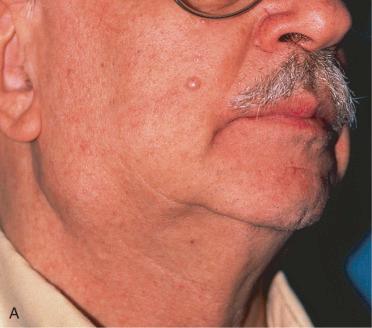
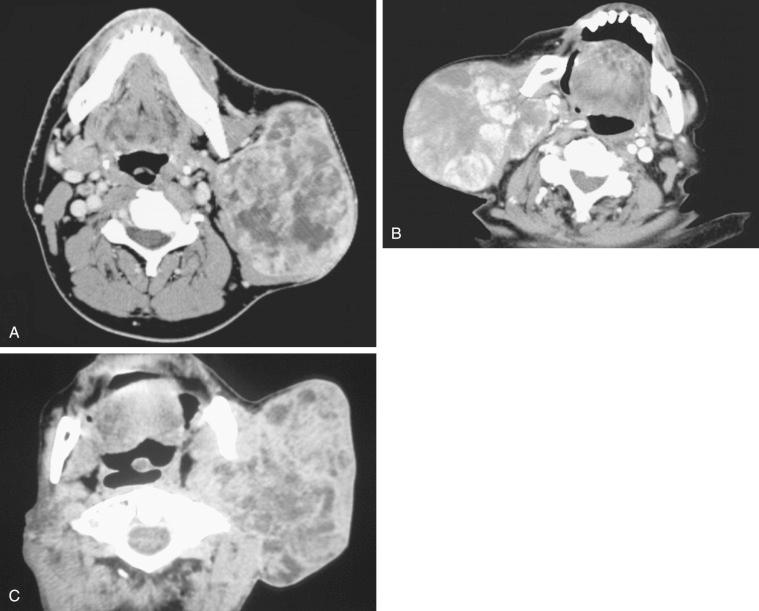
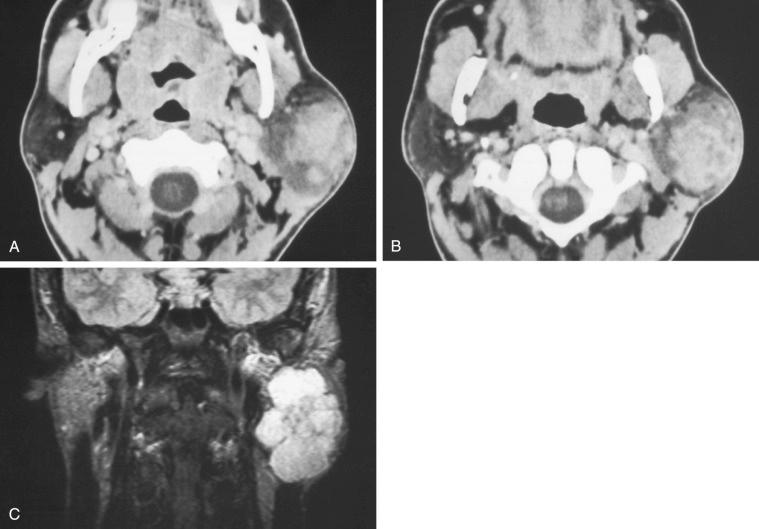
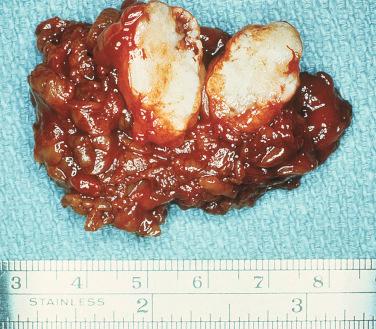
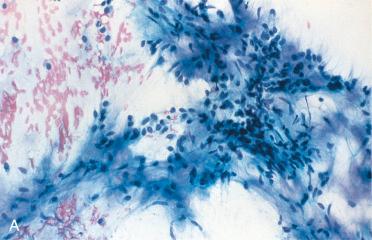
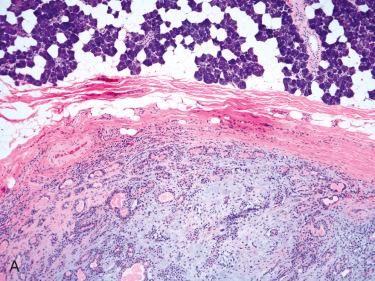
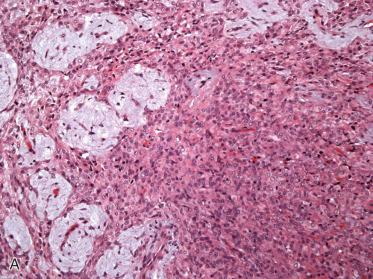
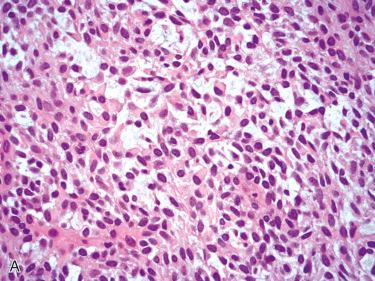
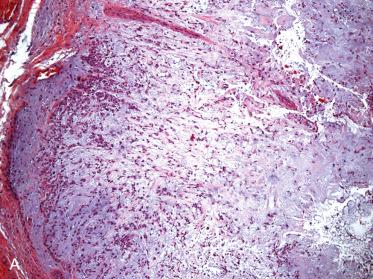
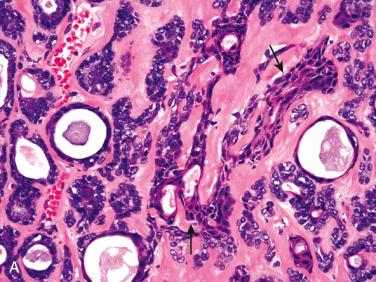

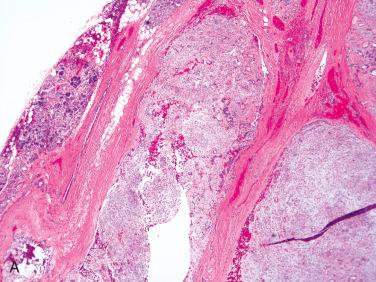
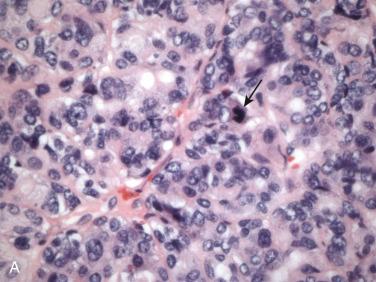

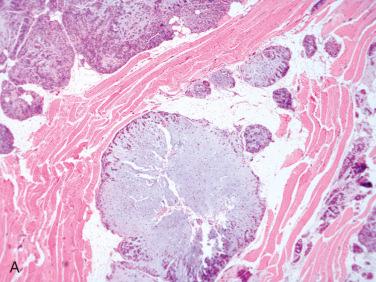
Represents most common neoplasm of salivary glands, accounting for 40% to 70% of all neoplasms of the parotid, submandibular glands, and minor salivary glands; PA of the sublingual glands is rare:
80% occur in parotid gland
10% occur in submandibular gland
10% occur in minor salivary glands
Slightly more common in women than men; occur over a wide age range but are most commonly seen in the third through sixth decades of life:
Most common salivary gland neoplasm in children and adolescents
Most common site of occurrence is tail of the parotid gland but it may also occur in the deep lobe of the parotid, in the submandibular and sublingual glands, and in all minor salivary glands throughout the upper and lower respiratory tract:
PA of parotid gland occurs primarily (but not exclusively) in the superficial lobe (i.e., superficial plane to facial nerve)
PAs of deep lobe of parotid gland may present as a parapharyngeal space mass.
Involvement of minor salivary glands occurs most frequently on the palate (hard and soft), but other common sites include the upper lip and buccal mucosa.
May occur in the sinonasal tract:
Involve the septum (bony or cartilaginous portion) but may arise in the lateral wall
Tend to be myoepithelial-predominant neoplasms
Multiple tumors or bilateral tumors are uncommon.
Symptoms vary according to site:
Most are slow-growing, painless masses present for periods up to several years.
Other symptoms, in particular those occurring in the minor salivary glands, may include:
Difficulties in chewing, dysphagia, dyspnea, hoarseness, and epistaxis
May ulcerate overlying mucosa
In parotid gland, the tumor typically occurs outside of the facial nerve, and facial nerve involvement typified by facial nerve paralysis is rare and, if present, should be suspicious for malignancy:
Infarcted PAs may uncommonly be associated with pain or facial palsy.
Parapharyngeal space PAs:
Represent most common tumor of the parapharyngeal space (followed by peripheral nerve sheath tumors)
Usually present as an asymptomatic (cervical or intraoral) mass; other symptoms may include obstruction, unilateral conductive hearing loss, and serous otitis media
Parapharyngeal space is a potential space between the lateral wall of the pharynx, internal pterygoid muscle, and cervical vertebrae:
Other structures located within this space include cranial nerves IX through XII, great vessels of the neck, mature adipose tissue, and lymph nodes.
Despite efforts in localization of key proteins using immunohistochemistry, the complex proteomic composition of pleomorphic adenomas (PA) has not yet been characterized.
Matrix-assisted laser desorption/ionization imaging mass spectrometry (MALDI-imaging):
Allows label-free and spatially resolved detection of hundreds of proteins directly from tissue sections and of histomorphologic regions by finding co-localized molecular signals
Spatial segmentation of MALDI-imaging data is algorithmic method for finding regions of similar proteomic composition as functionally similar regions.
MALDI-imaging of pleomorphic adenoma (two cases reported to date):
Spatial segmentation subdivided tissue in good accordance with the tissue histology
Numerous molecular signals co-localized with histologically defined tissue regions were found.
Highlighted cellular trans-differentiation within the PA
Spatial segmentation of MALDI-imaging data represents promising approach in emerging field of digital histologic analysis and characterization of tumors.
Cause
No known etiologic factors
Familial occurrence rare
Firm, freely movable, unifocal mass:
Encapsulated or well-demarcated, tan-white, and solid in appearance
May demonstrate cystic change
Ulceration of overlying skin does not occur.
Vary in size from a few centimeters up to large, disfiguring masses
Minor salivary gland tumors are polypoid or lobulated, encapsulated or well-delineated, tan-white, usually measuring 1 to 2 cm but capable of attaining sizes of 7 cm or more.
Recurrent tumors tend to be multinodular.
Usually readily diagnosed by FNAB due to the presence of epithelial and stromal elements
Morphologic diversity including:
Background filled with mucoid to fibromyxoid ground substance varying from fibrillar to myxomatous to chondroid and appearing:
Bright pink or magenta on Romanovsky stain
Bluish purple on Papanicolaou stain
Clusters of plasmacytoid or spindle-shaped (myoepithelial) cells:
Embedded in stromal matrix
Cohesive groups of epithelial cells with bland cytology including round to oval nuclei with fine-appearing chromatin:
Identified in continuity with the stromal material
Other cellular elements and/or findings that can be seen include:
Squamous cells (with or without keratinization)
Oncocytic cells
Sebaceous cells
Tyrosine-like crystals appearing as crystalline deposits resembling the petals of a flower:
Not pathognomonic for pleomorphic adenoma as can be seen in nonneoplastic salivary gland lesions (e.g., parotid cysts) and in other neoplasms (e.g., polymorphous low-grade adenocarcinoma, others)
Intranuclear inclusions
Degree of cellularity varies from case to case and even within the same case.
Cellular pleomorphic adenomas:
Presence of cellular aspirate and relative absence of stromal component, especially if nuclear atypia is present, may present diagnostic problems in recognition as benign and in differentiating from carcinomas.
Cellular aspirates lacking stromal component and lacking nuclear atypia can be diagnosed as a “salivary gland neoplasm, not otherwise specified,” which would then prompt surgical removal and histologic evaluation.
In major salivary glands are encapsulated but fibrous capsule varies in thickness and may be thin or even absent:
Prominently myxoid tumors often have incomplete capsules and there may be juxtaposition of the tumor to adjacent normal salivary gland.
May be multinodular:
Nodules may be separate from one another.
Not diagnostic for malignancy
May have irregular growth along periphery of lesion, including lesional cells extending into capsule and/or fat:
Capsular extension not diagnostic for carcinoma
Fat may be inherent component of tumor so that lesional cells extending into fat but still within the confines of a capsule are still within the spectrum of a benign neoplasm and not diagnostic for malignancy.
In minor salivary glands generally not encapsulated but typically circumscribed or well demarcated:
Extension and involvement of surface epithelium not diagnostic feature for malignancy
Histologic appearance includes an admixture of epithelial, myoepithelial, and stromal components.
Morphologic variability (i.e., polymorphism) can be seen from case to case and within a single neoplasm:
Growth patterns may include tubular/ductular, solid, cystic, trabecular, cribriform, papillary, reticular, or lattice-like and schwannoma-like.
Duct-lining epithelial cells form the inner layer of acini or tubules and appear flattened, cuboidal, or columnar with round to oval nuclei and a variable amount of cytoplasm appearing eosinophilic to amphophilic.
Myoepithelial component forms the outer layer and may appear:
Spindle-shaped, plasmacytoid (hyaline), cuboidal, epithelioid, clear-appearing cells
Plasmacytoid myoepithelial cells are oval with round nuclei eccentrically located and abundant eosinophilic hyaline cytoplasm
Absence of perinuclear Golgi zone
Stromal component, the product of myoepithelial cells, varies in appearance from myxoid to (hyaline) chondroid to chondromyxoid and may also appear fibrous and vascular:
Any one or all of these components may coexist in the same neoplasm.
Quantity ranges from case to case and even within a given case and may be abundant or scanty.
Presence of any stromal component as detailed above allows for classification as pleomorphic adenoma rather than monomorphic adenoma.
Extracellular crystalloids may be identified, particularly in the nonepithelial areas:
Crystalloids are more often present in PA than in any other salivary gland tumor but may be present in other tumor types, including polymorphous low-grade adenocarcinoma.
Other cell components may include:
Squamous cells with or without keratinization
Mucous cells
Clear cells, sebaceous cells, oncocytic cells
Calcification and fat
Minor salivary pleomorphic adenomas tend to be cellular and are circumscribed but unencapsulated.
Those occurring in the nasal cavity (particularly the septum) tend to have an increased plasmacytoid-appearing myoepithelial component.
Multicentric pleomorphic adenomas are rare.
Recurrent tumors are often multinodular and frequently chondromyxoid-predominant.
Post–fine-needle aspiration biopsy changes:
Secondary changes may occur following prior manipulation or fine-needle aspiration biopsy and may include:
Squamous metaplasia, including keratinization and/or intercellular bridges
Mucous cell metaplasia
Hemorrhage and cholesterol granuloma formation
Calcifications and psammomatoid concretions
“Pseudoinvasion” or bulging into the capsule
Necrosis/infarction
Spontaneous necrosis in a PA may occur, but the presence of necrosis/infarction in the absence of prior manipulation should raise concern for the possibility of malignancy.
Neoplasm showing residual foci diagnostic for pleomorphic adenoma, even if only limited in extent, but dominated by epithelial, myoepithelial, or stromal component
Neoplasms with overabundance of epithelial cells, myoepithelial cells, or mesenchymal component categorized respectively as:
Epithelial-predominant pleomorphic adenoma
Myoepithelial-predominant pleomorphic adenoma
Chondromyxoid-predominant pleomorphic adenoma
In association with increased cellularity there may be nuclear pleomorphism, including bizarre-appearing (“monster”) cells and scattered mitotic figures, raising additional concern for possible diagnosis of malignancy:
Typically, bizarre cells are limited in extent and often relegated to focal areas of the tumor.
Mitotic figures may be identified in any given tumor but often are limited in number.
Increased mitotic figures can be seen in any given neoplasm and solely in the absence of other findings does not constitute a diagnostic feature for carcinoma
Presence of atypical mitotic figures not typically found in pleomorphic adenomas
Rare cases may show vascular permeation but by itself this feature is not indicative of malignancy:
Intravascular location of neoplastic cells can be confirmed by CD31, CD34, and factor VIII–related antigen immunostains.
Biologic significance not completely clear but evidence supports innocuous phenomenon in a majority of cases likely related to artifactual spillage caused by tumor injury presumably by prior fine-needle aspiration or surgery.
Despite the presence of increased cellularity even with bizarre cells and mitoses, there is absence of features raising concern for malignancy.
Atypical histologic features seen in PAs that may portend transformation to a carcinoma include:
Diffuse nuclear atypia (anaplasia)
Atypical mitoses
Prominent zones of (acellular) hyalinization
Pleomorphic adenomas with prominent zones of hyalinization are more likely to develop carcinoma than pleomorphic adenomas without such hyalinization.
Coagulative tumor necrosis
Presence of atypical features should prompt extensive sectioning and histologic examination of the specimen to exclude findings that may be diagnostic for malignancy.
Often but not always tend to be chondromyxoid predominant
Often multinodular and may include:
Innumerable variably sized, well-circumscribed nodules
Extensive involvement of soft tissues of the neck, including into skeletal muscle and fat
In spite of multinodularity retain benign cytomorphologic features
For all pleomorphic adenomas:
Histochemistry:
Intraluminal epithelial mucin may be demonstrated by diastase-resistant, periodic acid Schiff–positive, and mucicarmine-positive material.
Stromal component is alcian blue positive but mucicarmine negative
Immunohistochemistry (IHC):
Epithelial cells:
Cytokeratins, CEA and EMA positive
May be CD117 (c-kit) positive
Myoepithelial cells:
Cytokeratins, p63, p40, calponin, S100 protein, glial fibrillary acidic protein, actin and vimentin positive
CEA and EMA negative
Pleomorphic adenoma gene 1 (PLAG1) consistently positive in PAs (nuclear) in epithelial and myoepithelial cells
SOX10 positive (nuclear) in epithelial and myoepithelial cells
Low proliferation indicates by Ki67 (MIB1) staining typically less than 5%:
Although not definitively
Absent to rare p53 reactivity
Weak bcl-2 reactivity
NOTE: IHC staining characteristics of PAs variable from case to case and even within a given case and do not necessarily show consistent staining patterns reported in the literature
Molecular biology:
70% of PAs are karyotypically abnormal, including:
8q12 rearrangements:
Translocations include t(3;8)(p21;q12) and t(5;8)(p13;q12)
Target gene, pleomorphic adenoma gene 1 ( PLAG1), mapped to 8q12
12q14-15 rearrangements:
Translocations include t(9;12)(p24;q14-15) or ins(9;12)(p24;q12q15)
Target gene is the high mobility group protein gene, high mobility group AT-hook 2 ( HMGA2 )
NOTE: To date, PLAG1 and HMGA2 not reported in any other salivary gland neoplasms (except carcinoma ex pleomorphic adenoma)
Sporadic or clonal changes not 8q12 or 12q 13-15 rearrangements
Normal karyotype may be present.
In general, diagnosis of pleomorphic adenoma does not present difficulties; however, in cellular tumors with a variety of growth patterns, particularly involving minor salivary glands (i.e., intraoral), pleomorphic adenomas may prove difficult to differentiate from other tumors including:
Monomorphic adenoma (MA):
Presence or absence of mesenchymal component differentiates PA from MA.
Identification of mesenchymal component in any given case can be problematic, but in such a situation decision is between two benign neoplasms so treatment and prognosis are similar.
Polymorphous low-grade adenocarcinoma (PLGA) of minor salivary gland origin:
Many overlapping findings with PAs so in limited sampling will be problematic in differentiating it from PA (see immediately below for use of p63/p40 immunostaining in the differential diagnosis)
Adenoid cystic carcinoma:
In contrast to PAs, adenoid cystic carcinomas reported to have:
Increased proliferation indices
Increase in p53 staining
Strong bcl-2 staining
Further IHC findings including pairing p63 and p40 reported to assist in differentiating PA from polymorphous low-grade adenocarcinoma (PLGA) and adenoid cystic carcinoma (AdCC) include:
PA: p63 + (68%; 21/31) and p40+ (42%; 13/31) immunophenotype
Discordant p63+/p40− staining pattern seen only in overtly mesenchymal chondromyxoid stroma
Cellular PA: concordant p63+/p40+ or p63−/p40− immunophenotypes
PLGA: consistent p63+ (100%; 11/11) and p40− (100%; 11/11) immunophenotype
AdCC: p63 + (90%; 91 of 101) and p40+ (89%; 90/101) immunophenotype
Single discordant p63+/p40− case was solid variant with high-grade features
Proliferation indices (Ki67):
Low proliferation indices seen in association with PA, cellular PA, and PLGA typically less than 5%
Proliferative indices reported to be significantly higher in AdCC (up to approximately 20%)
Increased proliferation indices may not be present in all cases of AdCC and by itself does not unequivocally differentiate it from PA, cellular PA, and PLGA.
CAUTIONARY NOTE: Although a p63/p40 immunohistochemical panel can be a valuable tool for making distinction between PA, PLGA, and AdCC, it is not infallible and any given example may demonstrate divergence from the reported p63/p40 immunophenotype.
Mucoepidermoid carcinoma (MEC):
In those examples of PA with squamous and mucinous cell metaplasia differentiation from MEC can be somewhat problematic:
Presence of keratinization and intercellular bridges associated with squamous metaplasia of PA contrasts to the epidermoid component of MEC typically lacking keratinization and intercellular bridges.
Metaplastic PAs do not harbor translocations t(11;19) and anticipated t(11;15) resulting in CRTC1-MAML2 and CRTC3-MAML2 fusion transcripts, respectively, and/or MAML2 gene rearrangement found in association with MEC.
Deep-seated dermal adnexal neoplasm
Mesenchymal neoplasm:
Peripheral nerve sheath tumor
Smooth muscle neoplasms
| Tumor | Encapsulation | Growth Patterns | Cytomorphology | Stroma | IHC | Cytogenetic |
|---|---|---|---|---|---|---|
| PA | Absent but well circumscribed | Polymorphic including tubules, ribbons, sheets, cords, cysts, trabeculae | Dual cell population: ducts/glands and myoepithelial cells; no necrosis or increased mitotic activity; intercellular hyaline material may be present | Chondromyxoid; crystalloids may be present | Positive for epithelial and myoepithelial markers: CKs, p63, p40, S100 protein, PLAG1 others; low proliferation indices | PLAG1 HMGA2 |
| CPA (E or M) | Absent but well circumscribed | Polymorphic including tubules, ribbons, sheets, cords, cysts, trabecular, fascicular, anastomosing cords | Dual cell population: ducts/glands and myoepithelial cells; for myoepithelial predominant tumors lesional cells include spindle-shaped and plasmacytoid cells but ducts/glands focally seen; no necrosis or increased mitotic activity; intercellular hyaline material may be present | Scanty but identifiable chondromyxoid stroma; crystalloids may be present | Positive for epithelial and myoepithelial markers: CKs, p63, S100 protein, others; low proliferation indices | PLAG1 HMGA2 |
| PLGA | Absent and infiltrative | Polymorphic including tubular/ductules, cribriform, solid, linear single cell, “streaming” along periphery, papillary | Isomorphic cells with minimal pleomorphism; no necrosis or increased mitotic activity; intercellular hyaline material may be present | Slate gray myxoid; crystalloids may be present | Positive for epithelial and myoepithelial markers: CKs, p63, S100 protein, others; p40 negative * ; PLAG1 usually negative; low proliferation indices | None known although PRKD2 rearrangement reported in a single case |
| AdCC tubular, cribriform | Absent and infiltrative | Polymorphic including cribriform, tubular/ductules, islands, cysts, nests, cords, solid | Basaloid cells with uniform, angulated, hyperchromatic nuclei, scanty cytoplasm; no necrosis or increased mitotic activity; intercellular hyaline material present | Myxoid-hyaline stroma | Positive for epithelial and myoepithelial markers: CK, p63, p40, S100 protein, others; PLAG1 negative; increase proliferation indices † | MYB-NFIB |
* p40 not necessarily consistently negative in PLGA or positive in the other neoplasms.
† Increase proliferation indices may not be present in all cases of AdCC and by itself does not definitively differentiate it from PA, cellular PA and PLGA.
Complete surgical excision is preferred treatment:
Parotid gland tumors usually require lobectomy with preservation of the facial nerve.
Submandibular gland tumors usually necessitate complete removal.
Minor salivary glands neoplasms require complete but conservative excision.
Incomplete excision irrespective of site results in recurrent tumor:
Increase risk of recurrence associated with:
Inadequate surgery:
Enucleation
Rupture or spillage during surgery
Chondromyxoid-predominant PAs:
Diffluent nature results in “spillage.”
Variable capsular thickness coupled with tendency of tumor to invade capsule and/or bulge through capsule
Young age
Recurrent tumors may be multifocal and in some cases may be widely distributed throughout the soft tissues of the neck, precluding surgical resection to control local disease:
Low-dose radiation may be used in this situation.
Presence of scar tissue in association with the recurrent tumor may present difficulties relative to the facial nerve with adherence to the nerve.
Preservation of the nerve with excision of the scar tissue and the entire parotid gland is recommended for recurrent tumor.
Overall prognosis for PA is excellent with:
5-year recurrence-free rate of 97%
10-year recurrence-free rate of 94%
Complications include malignant transformation (carcinoma ex pleomorphic adenoma) and the rare occurrence of so-called benign metastasizing pleomorphic adenoma.
Surgical complications may include nerve damage and Frey syndrome (gustatory sweating).
Features that may indicate a greater likelihood of malignant transformation include:
Occurrence in submandibular gland
Older patient age
Long-standing tumor
Larger tumor size
Prominent areas of acellular hyalinization
Increased mitotic activity including atypical mitoses
Any salivary gland PA may show histologic features that raise concern for malignancy:
Neoplastic tissue within or extending through the fibrous capsule causes concern for malignant transformation; however, by itself capsular involvement in an otherwise unremarkable PA is acceptable and is not an indication of malignant transformation.
Rare cases of PA may show vascular permeation but by itself this feature is not indicative of malignancy.
Recurrent PA often have multiple foci of tumor within the normal salivary gland but these foci are usually discrete and circumscribed without cytologic atypia (they may show a prominent chondromyxoid stroma).
Treatment for an atypical pleomorphic adenoma is similar to “conventional” pleomorphic adenoma albeit perhaps with more vigilant follow-up.
Definition: Benign tumors of salivary glands characterized by a lack of the mesenchyme-like stromal component as seen in pleomorphic adenomas and composed exclusively of the epithelial component or less commonly, myoepithelial component, and arranged in a variety of morphologic patterns.
Monomorphic adenomas encompass a whole group of neoplasms that are not pleomorphic adenomas.
Definition: Benign salivary gland tumor characterized by its readily recognizable morphologic appearance composed of bilayered epithelium, including inner columnar oncocytic cells surrounded by smaller basaloid cells, and forming multiple cysts and papillary structures that are separate from a mature lymphocytic cell stroma.
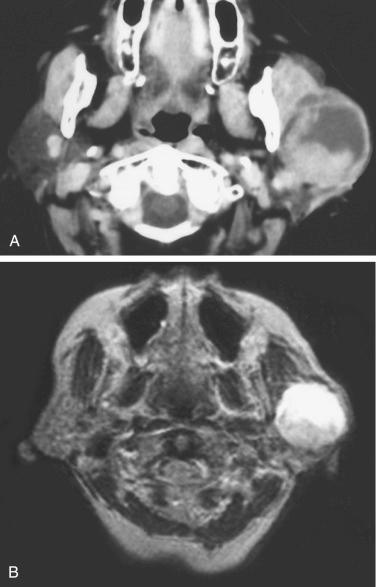

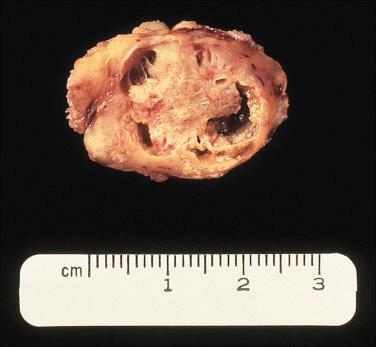
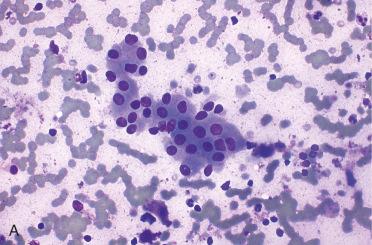
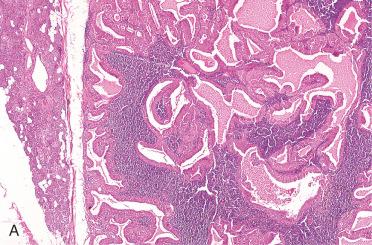
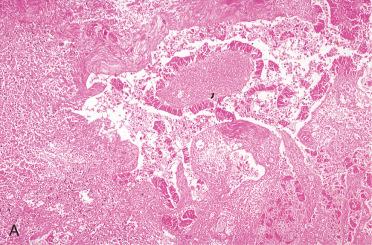
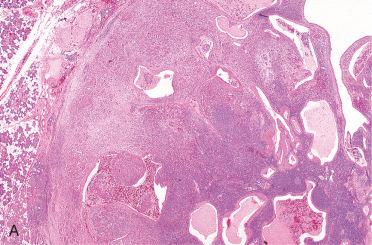
Synonyms: Papillary cystadenoma lymphomatosum; adenolymphoma; cystadenolymphoma
Represents second most common benign salivary gland tumor (following pleomorphic adenoma) accounting for approximately 5% to 6% of all salivary gland tumors and up to 12% of benign parotid gland tumors
More common in men than in women:
Recent evidence shows marked decline in incidence in men with increased prevalence in women.
These demographic changes have been linked to smoking habits with a decline in use by men and an increase of use in women.
Smoking has been considered as an established risk factor for the development of Warthin tumor.
Occurs over a wide age range but is most common in the fifth through seventh decades of life; uncommon to occur in the first three decades of life
Almost exclusively involves parotid gland, particularly in the superficial lobe along the inferior pole adjacent to the angle of the mandible; rare cases reported in submandibular gland, palate, lip, tonsil, larynx, and maxillary sinus
Bilateral tumors can be seen in up to 10% of cases and multifocal tumors in up to 12% of cases:
Bilateral or multifocal tumors may occur synchronously or metachronously.
Most common symptom is painless mass; rarely is pain an associated complaint.
May occur synchronously or metachronously with other salivary gland tumors, including:
Pleomorphic adenoma (most common), monomorphic adenomas, oncocytoma, basal cell adenoma, acinic cell adenocarcinoma, ductal adenocarcinoma, and adenoid cystic carcinoma
Radiology:
CT scan:
Well-defined area of increased density in the posteroinferior segment of the superficial lobe of the parotid
Radionucleotide imaging:
Increased uptake of technetium-99m, which does not wash out following dialogue administration; this finding plays an important role in diagnosis and is related to the presence of oncocytes and their increased mitochondrial content.
Cause:
Strong link with cigarette smoking
Radiation exposure has been linked as a tumorigenetic factor.
Role of Epstein-Barr virus (EBV) in the development of Warthin tumor is controversial:
Some studies document the presence of EBV in the cytoplasm of luminal cells of WT, whereas other studies do not identify EBV in WT.
No substantiation that EBV plays a role in development of WT.
Pathogenesis
Thought to develop from neoplastic transformation of entrapped salivary duct epithelium within intra- and periparotid lymph nodes during embryologic development; in support of this theory includes:
Ontogenically, parotid gland is last of the salivary glands to be encapsulated, resulting in either incorporation/entrapment of lymphoid tissue within the parotid or incorporation/entrapment of parotid ducts and acini within the periparotid lymph node epithelium
Identification in some cases of subcapsular sinuses, a normal feature of lymph nodes and not a normal feature of non-lymph node tissues (i.e., salivary glands)
Occurrence in periparotid lymph nodes
Presence of B- and T-cell markers in the lymphoid component of Warthin tumors
Encapsulated, soft and fluctuant, round to oval mass with a smooth or lobulated surface composed of tan-brown tissue with multiple cystic spaces from which a mucoid or brown exudate may be expressed; within the cystic spaces papillary projections are seen
Solid areas can be identified and are noted for a white nodular appearance representative of lymphoid follicles.
Measures from 1 to 8 cm in diameter
Combination of oncocytic-appearing epithelial cells and mature lymphocytes
Oncocytic epithelial cells appear in cohesive clusters as well as individual cells and may take on a honeycomb arrangement; these cells are characterized by the presence of:
Abundant granular and eosinophilic-appearing cytoplasm
Uniform round nuclei often centrally located with identifiable nucleoli
Distinct cell borders
Absence of lymphocytes in the epithelial cluster
Occasionally, squamous (metaplastic) cells may be identified.
Background of aspirate may appear “dirty” with cellular debris and associated lymphoid cells:
Given cystic character of Warthin tumor, FNAB may yield thick, tan-brown fluid.
The fluid may suggest the presence of mucus.
In conjunction with epithelial clusters and lymphoid cells this overall appearance may engender a diagnosis of mucoepidermoid carcinoma.
Papillary and cystic lesion composed of epithelial and lymphoid components
Epithelial component lining the papillary projections composed of double layer of granular eosinophilic cells (referred to as oncocytic epithelia):
Inner or luminal cells:
Nonciliated, tall columnar cells with nuclei aligned toward the luminal aspect
Prominent oncocytic appearance of the cells is due to the presence of increased mitochondrial content.
Outer or basal cells:
Round, cuboidal, or polygonal cells with vesicular nuclei
Lymphoid component predominantly composed of mature lymphocytes containing lymphoid follicles with germinal centers:
Epithelial component is sharply demarcated from the lymphoid component.
Other inflammatory cells that may be seen include plasma cells, histiocytes, mast cells, and occasional multinucleated (Langhans type) giant cells.
Mucus-secreting (goblet) cells and sebaceous glands can be seen.
Squamous metaplasia and focal necrosis may be seen in association with secondary inflammation.
Lumens of the cysts may contain thick secretions, cholesterol crystals, cellular debris, or corpora amylacea–like laminated bodies.
Post–fine-needle aspiration biopsy changes:
As is true of other tumors with prominent oncocytic cells, these tumors are subject to degenerative alterations either spontaneously or following needle aspiration (or biopsy), including:
Infarction and necrosis
Cytologic atypia
Metaplasia (squamous cell, mucous cell)
Granulation tissue
Acute and chronic inflammation
Fibrosis
Hemorrhage (recent and remote)
Pseudoinfiltrative pattern
Metaplastic or infarcted variant of Warthin tumor:
Accounts for less than 10% of all Warthin tumors
Most likely develops following prior manipulation (e.g., fine-needle aspiration biopsy)
Extensive necrosis is present with ghost-like papillary structures remaining
Squamous and mucous cell metaplasia may be present.
Cytologic atypia may be prominent.
Increased mitotic figures but absence of atypical mitoses
Extensive fibrosis with dense collagen and reactive myofibroblasts are present along the periphery of the tumor.
Mixed acute and chronic inflammation, including neutrophils, mature lymphocytes, histiocytes, and foamy macrophages may be present.
Additional alterations may include lipogranulomas, cholesterol granulomas
Residual noninfarcted foci of Warthin tumor may be present.
Histochemistry:
Phosphotungstic acid-hematoxylin (PTAH) stains demonstrate mitochondria as seen by blue-black granules in the cytoplasm of both epithelial cell layers.
Immunohistochemistry:
Epithelial cells: cytokeratins positive
Lymphoid cells: reactivity for B-cell (CD20) and T-cell (CD3) markers, as well as CD56, CD4 (helper cells), and CD8 (suppressor cells).
Sox10 negative
Cytogenetics and molecular genetics:
Absence of CRTC1-MAML2 fusion:
Documentation in literature of this gene fusion, commonly found in mucoepidermoid carcinomas (see below), in WT but not substantiated
Histology of WT so characteristic that its diagnosis presents limited difficulty
Cystadenoma
Oncocytic papillary cystadenoma (for those cases identified in unusual sites)
Salivary gland tumors/lesions with oncocytic cells either focally or a predominant component including:
Oncocytoma; oncocytosis; mucoepidermoid carcinoma, acinic cell carcinoma, others
Mucoepidermoid carcinoma:
In those examples of WT with squamous and mucinous cell metaplasia differentiation from MEC can be somewhat problematic:
Metaplastic WTs do not harbor translocations t(11;19) and anticipated t(11;15) resulting in CRTC1-MAML2 and CRTC3-MAML2 fusion transcripts, respectively, and/or MAML2 gene rearrangement found in association with MEC.
Complete surgical excision is the preferred treatment and should include an adequate margin of uninvolved tissue as well as preservation of facial nerve.
Locally recurrent tumor may occur and is related to inadequate excision or to multicentrically occurring neoplasms.
Transformation to malignant Warthin tumor is exceedingly rare with an incidence of less than 0.1% and may include the:
Epithelial component (carcinoma ex Warthin tumor):
Squamous cell carcinoma (most common), oncocytic carcinoma, adenocarcinoma not otherwise specified, undifferentiated carcinoma, mucoepidermoid carcinoma, Merkel cell carcinoma:
Metastasis to regional lymph nodes may occur.
Rarely, distant metastasis may occur.
Lymphoid component:
Malignant lymphoma, usually non-Hodgkin type
Definition: Benign neoplasm characterized by proliferation of basaloid-appearing cells and absence of mesenchyme-like stromal component seen in pleomorphic adenoma.
Subdivided into four histologic subtypes based on morphologic pattern, including:
Solid
Trabecular
Tubular
Membranous types: only one associated with unique clinicopathologic findings (see below)
Synonym: Dermal analogue tumor is another name that has been used for the membranous type of basal cell adenoma.
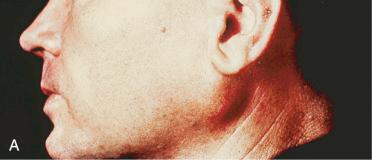
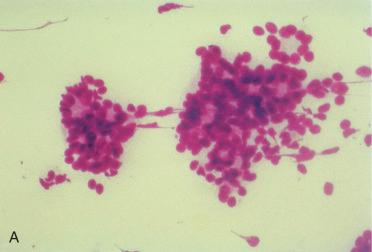
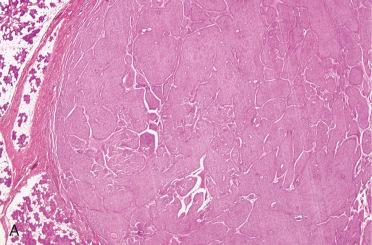
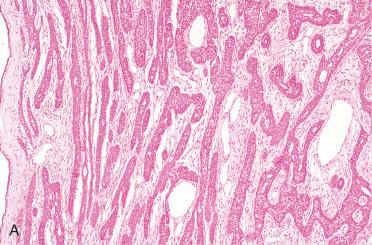
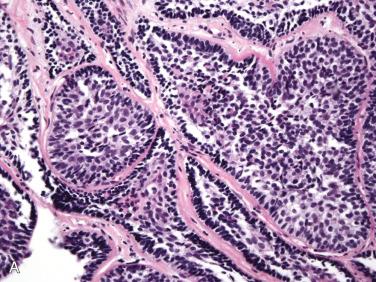
Accounts for approximately 2% of all salivary gland tumors
No gender predilection; occurs over a wide age range from the fourth to ninth decades of life
Most common site of occurrence is major salivary glands particularly in the parotid gland (superficial lobe):
70% occur in parotid gland
Up to 20% occur in the upper lip
Involvement of other minor salivary glands occurs but is uncommon
Symptoms vary according to site but most frequently presents as a freely mobile, asymptomatic mass with a growth period ranging from months to several decades
Lip or palatal tumors may be associated with ulceration.
Cause unknown
Membranous type of basal cell adenoma:
Also referred to as dermal analogue tumor
Distinctive variant:
90% occurrence in men
Frequently multicentric/multifocal and unencapsulated
Familial cases associated with:
Dermal cylindroma (most common)
Trichoepithelioma
Eccrine spiradenoma
Milia
Germline mutation of cylindromatosis gene (CYLD), tumor suppressor gene located at chromosome 16q12-q13 implicated in familial cases
Somatic mutations of gene found in sporadic cases
FNAB diagnosis may be problematic given overlapping features with pleomorphic adenoma, adenoid cystic carcinoma, and basal cell adenocarcinoma.
Cellular aspirate including sheets, trabeculae, and tubular structures composed of uniform cells with hyperchromatic round to oval nuclei and scanty cytoplasm:
Cells are small with high nuclear-to-cytoplasmic ratio.
Stromal component tends to be scanty.
Extracellular basement membrane–like material may be present, especially in the membranous type of basal cell adenoma, appearing as amorphous eosinophilic material, including spheric globules, findings that may raise the diagnosis of adenoid cystic carcinoma.
Collagenous stroma interdigitates with adjacent tumor cells:
This feature has been suggested as useful in differentiating basal cell adenoma from adenoid cystic carcinoma.
Major glands:
Encapsulated, tan-white to red-pink, solid mass measuring up to 4 cm in diameter
Minor salivary glands:
Similar to those of major salivary glands except that, although well circumscribed, they often are unencapsulated
May be associated with surface ulceration
Encapsulated neoplasm that may show variety of growth patterns allowing for subclassification into:
Solid
Trabecular
Tubular
Membranous types
Combination of patterns can be seen in any given case.
Cribriform growth may be present.
Irrespective of growth composed of two cell types:
Small cells with hyperchromatic nuclei and indistinct cytoplasm usually (but not always) seen at the periphery of the cell nests:
These cells may be arranged in a palisading pattern around the periphery of tumor cords or islands in manner similar to cutaneous basal cell carcinomas but usually without retraction artifact from the surrounding stroma.
Larger polygonal-shaped cells with pale-staining nuclei, more abundant but indistinct cytoplasm usually more centrally located in cell nests
In addition, these cells may form squamous whorls or eddies.
Myoepithelial rich stroma may be present in some cases characterized by:
Stromal spindle-shaped cells
S100 positive but p63 and actin negative
Presence of stromal myoepithelial cells assists in differentiation from adenoid cystic carcinoma, which lacks such stromal cells
Solid basal cell adenoma:
Most common histologic variant
Solid masses of basal cells composed of small, isomorphic cells with uniform, hyperchromatic, round to oval nuclei and indistinct cytoplasm
Peripheral aspect of these nests are characterized by nuclear palisading
Scant stroma is present from which the epithelial islands are sharply demarcated by an intact membrane.
Squamous cells and squamous whorled eddies (“keratin pearls”) can be seen as a terminal expansion of the epithelial islands.
Mitoses are generally absent.
Trabecular basal cell adenoma:
Basal cell proliferation growing in elongated, ribbon-like (trabecular) pattern with the cell islands separated by proliferation of a prominent vascular (capillary) stroma.
Tubular basal cell adenoma:
Basal cell proliferation composed of multiple small duct-like structures lined by columnar-appearing cells with uniform, hyperchromatic, round to oval nuclei
Tubules are well-demarcated from the stroma by an intact membrane.
Stroma is noteworthy for the presence of prominent vascular pattern consisting of capillaries and venules.
Mitoses are generally absent.
Tubular-trabecular adenoma:
Presence of tubular and trabecular patterns
Cellular stroma composed of myoepithelial cells
Membranous basal cell adenoma:
In contrast to the other types, the membranous basal cell adenoma may be multilobular and frequently unencapsulated (present in only approximately 50% of cases).
Characterized by the presence of thick eosinophilic hyalin membranes surrounding and separating cell islands and creating a jigsaw puzzle appearance; this material represents reduplicated basal lamina and its appearance is similar to that of the dermal cylindroma, prompting the synonym of dermal analogue tumor.
Eosinophilic hyalin material can also be seen within the tumor islands and is diastase-resistant periodic acid-Schiff positive.
Tumor nests are often separated by normal salivary gland parenchyma, giving the appearance of multifocal growth.
Mitoses are generally absent.
Perineural invasion is not seen.
Cribriform basal cell adenoma
Composed of jigsaw puzzle–like lobules with multiple cystic spaces (cribriform growth) in at least 30% of a given tumor
Merge with more characteristic foci of basal cell adenoma
Absence of invasive growth
May be mistaken for adenoid cystic carcinoma
Immunohistochemistry:
Staining patterns support ductal and myoepithelial differentiation, including:
Epithelial cells:
Cytokeratin (low molecular weight), CEA, EMA positive
Myoepithelial cells:
p63, calponin, S100 protein, actin and vimentin positive
Nuclear β-catenin staining may be present.
bcl-2 and c-kit (CD117) reactivity may be present.
Electron microscopy:
Ductal cells:
Microvilli, tight junctions, desmosomes
Myoepithelial cells:
Abundant microfilaments, desmosomes, junctional complexes, reduplicated basal lamina
Cytogenetics and molecular genetics:
Presence of CTNNB1 (β-catenin) gene mutation
Loss of heterozygosity at 16q12-13:
Similar finding as seen in dermal cylindroma
Association of Basal Cell Adenoma and Intercalated Duct Lesions (IDL)
IDL found to coexist with salivary and nonsalivary neoplasms.
Among salivary tumors, basal cell adenoma appears to be associated most frequently with IDL.
Tubular variant most commonly associated with IDL:
Less frequently, nontubular variants of basal cell adenoma may harbor foci of IDL.
Unique hybrid lesion containing basal cell adenoma and IDL with transitional area described
These findings have led to the hypothesis that IDL could be a precursor of basal cell adenoma.
Pleomorphic adenoma:
From a therapeutic and prognostic perspective there is no difference in therapy or outcome between pleomorphic and monomorphic adenomas.
Adenoid cystic carcinoma (solid type in particular)
Basal cell adenocarcinoma
Ameloblastoma
Complete surgical excision is preferred treatment and is curative.
Prognosis is excellent.
Local recurrences are unusual but may be seen and relate to inadequate surgical excision.
Membranous basal cell adenoma is most commonly associated with recurrence:
Recurrence rate of 25% reported
May be consequence of inadequate resection due to characteristic multifocal growth
Malignant transformation of basal cell adenomas is exceedingly rare:
Gives rise to other “basal” cell carcinomas:
Basal cell adenocarcinoma or adenoid cystic carcinoma
Tumors composed of a basal cell adenoma and adenoid cystic carcinoma and have been termed hybrid tumors
Gives rise to non-“basal” cell carcinomas:
Adenocarcinoma, not otherwise specified
Salivary duct carcinoma
Malignant transformation highest in association with the membranous type of basal cell adenoma:
Reported as high as 28%
Definition: Benign neoplasm with predilection for upper lip and distinct histomorphologic appearance, including branching and interconnecting cords of single and double cell thick rows of columnar epithelium and a loose stromal component.
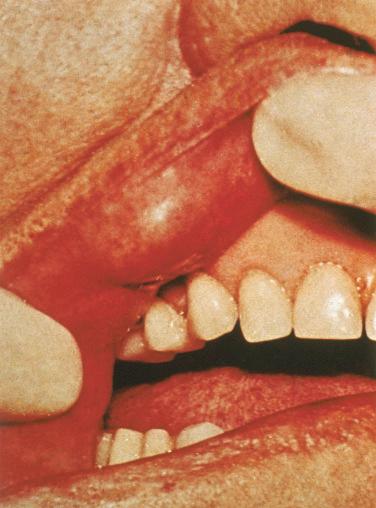
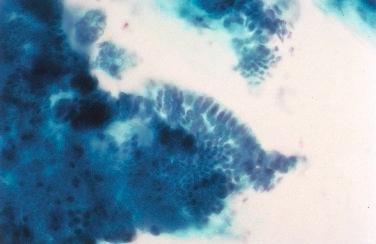
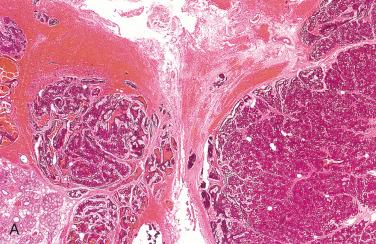
NOTE: Originally considered to be a variant of basal cell adenoma but recognized as a distinct salivary gland neoplasm.
No gender predilection, although reports have varied as to male predominance and female predominance; occurs over a wide age range from the fourth to ninth decades of life but most common in seventh decade
Almost exclusively limited to oral cavity, in particular, upper lip, which accounts for 70% to 90% of these tumors:
Other sites of occurrence include the buccal mucosa.
Infrequently, arises in parotid gland and palate
Symptoms include gradually enlarging, nonpainful, and nonulcerated nodule/mass:
Symptoms may be present for long periods of time (decades).
Multifocal nodular growths may be seen.
Clinically, may be confused for a mucocele, sebaceous cyst, or lipoma
Cellular aspirate that may include elongated, duct-like structures or tubules lined by columnar-appearing cells
Circumscribed and/or encapsulated, tan-pink to yellow-brown, rubbery to firm nodule measuring from 0.5 to 3 cm in diameter
Surface ulceration may be seen but is not common.
Cystic spaces and a gelatinous mucoid material may be identified in transecting the tumor.
Encapsulated or well-circumscribed nodules
Not infrequently include multifocal nodules
Scattered nodules may be small (clinically undetectable) and may be unencapsulated.
Consistent pattern of growth (unlike basal cell adenoma and other tumor types) and includes:
Double rows of columnar (basaloid) epithelial cells forming branching and interconnecting cords
Somewhat parallel arrangement of the rows of cells forms elongated duct-like structures resembling canals, hence the terminology of canalicular adenoma
Cystic dilatation of the canalicular structures may be present and may even be prominent in a given tumor.
Cords cut in cross-section may result in the presence of isolated tubules.
Alternating areas of tubules separated with closely apposed tubules is referred to as “beading,” creating an image of “beads on a string.”
Elongated duct-like structures or tubules are lined by cuboidal to columnar cells with uniform, hyperchromatic, round to oval nuclei, variable amount of eosinophilic to amphophilic cytoplasm, and indistinct cell borders; mitoses are generally absent.
Tubules are well demarcated from stroma by an intact membrane.
Stroma is edematous and noteworthy for the relative absence of cellularity (scattered fibroblasts are present) and for the presence of prominent vascular pattern consisting of capillaries and venules, some with an eosinophilic cuff likely representing basal lamina and collagen.
Histochemistry:
Diastase-sensitive, PAS-positive cytoplasmic granularity is seen.
Immunohistochemistry:
Cytokeratins (pancytokeratin, CK7, CK13), S100 protein and vimentin positive
Variable EMA reactivity
Distinctive GFAP linear immunoreactive pattern among cells in proximity to connective tissue interface reported
Little to no myoepithelial differentiation: absence of p63, calponin, smooth muscle actin, smooth muscle myosin heavy chain
Recent evidence based on morphologic, immunohistochemical, and ultrastructural findings support a cell of origin demonstrating features of intercalated duct cells and striated duct luminal epithelial cells, including:
IHC:
Positive nuclear staining for S100 protein, absence of CEA and GFAP
EM:
Abundant junctional complexes, including desmosomes and hemidesmosomes
Junctional complexes are associated with large aggregates of cytoplasmic intermediate filaments.
Focal microvillus projections forming intercellular lumina lined by abundant junctional complexes
Abundant cytoplasmic rough endoplasmic reticulum (rER) adjacent to the intercellular lumina and in apical aspects of the cells; rER is also seen near the basal lamina
Basal cell adenoma
Adenoid cystic carcinoma
Pleomorphic adenoma
Striated duct adenoma (SDA):
Has immunohistochemical similarities to canalicular adenoma, including positivity for S100 and essentially absent myoid markers and p63 staining
Histologic findings in SDA that are distinct from canalicular adenoma (CA) include:
SDA has relatively eosinophilic cytoplasm as compared with CA owing to abundance of mitochondria in the striated ductal cell cytoplasm.
Absence in SDA of characteristic ‘‘beading’' pattern and prominent stroma present in canalicular adenoma
Ameloblastoma
Cutaneous basal cell carcinoma
The multifocal growth of this neoplasm that is often devoid of a capsule can be mistaken for a carcinoma with invasion into the minor salivary gland parenchyma; awareness of this tendency reduces the likelihood of the erroneous diagnosis of carcinoma.
Conservative but complete surgical excision is the preferred treatment; enucleation is not recommended.
Recurrence following complete excision is uncommon.
Definition: Benign tumor of salivary gland origin exclusively composed of oncocytes, which are large epithelial cells with characteristic bright eosinophilic, granular cytoplasm due to the presence of increased intracytoplasmic mitochondrial content and the absence of myoepithelial or basal cells.
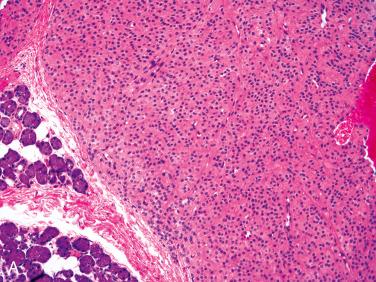
Synonym: Oxyphilic adenoma
NOTE: Oncocytic cells in salivary glands occur in the following settings:
Oncocytic metaplasia
Oncocytosis (nodular or diffuse)
Oncocytoma
Oncocytic carcinoma
Variety of other lesions/tumors that may have oncocytic cells (e.g., Warthin tumor, oncocytic variant of mucoepidermoid carcinoma, others)
Rare tumor composing less than 1% of all salivary gland neoplasms
No gender predilection; most commonly occurs in the sixth to eighth decades of life
Most frequently involves parotid gland but may also occur in the submandibular gland as well as in minor salivary glands throughout respiratory tract
Symptoms vary according to the site of occurrence and most frequently present as a painless mass; other symptoms include nasal or airway obstruction.
May occur synchronously with Warthin tumor
Radiology:
Similar to Warthin tumors and as a result of the mitochondrial hyperplasia, radionucleotide imaging demonstrates increased uptake of technetium-99m.
Stimulus for induction of oncocytic change is unknown but generally considered age related, rarely seen under 50 years of age and nearly always present above 70 years old:
Oncocytic cell changes are not limited to salivary glands but are seen in other organs, including:
Thyroid gland, parathyroid glands, adrenal glands, kidney, pancreas, others
Pathogenesis remains unclear. Some theories support a neoplastic growth, whereas others suggest a hyperplastic/metaplastic phenomenon:
Oncocytic tumorigenesis secondary to acquired mitochondrial dysfunction has been proposed as a plausible mechanism, but few tumors harbor mtDNA alterations within the control region to support this theory.
Smears show oncocytic cells characterized by cells with granular-appearing cytoplasm.
Oncocytic cells are arranged in sheets, papillary fragments, and as individual cells.
Cytologic atypia is absent or focal/limited in extent.
Typically, there is an absence of a lymphocytic cell component, but scattered lymphoid cells may be present:
Presence of lymphocytes in association with oncocytic cells may raise the diagnostic consideration of a Warthin tumor.
Major salivary glands:
Well-circumscribed, encapsulated, lobulated, solid mass with an orange to rust-colored appearance, rarely measuring more than 5.0 cm in diameter
Minor salivary glands:
Unencapsulated with less well-delineated borders with similar appearance and measurements as those of major glands; cystic change may be seen
Encapsulated tumor with solid, trabecular, cord-like or organoid growth pattern separated by a thin fibroconnective tissue stroma; tumors involving minor salivary glands tend to be unencapsulated with an irregular growth pattern and may demonstrate invasion of adjacent structures
Oncocytic cells represent a cytoplasmic alteration (metaplasia) of epithelial and/or myoepithelial cells with swelling of the cytoplasm by mitochondrial hyperplasia, giving the cell a characteristic granular eosinophilic appearance by light microscopy.
Predominant/exclusive cell is enlarged and polyhedral in shape with a distinct cell membrane and characterized by an abundant granular eosinophilic cytoplasm and a centrally placed round, vesicular-appearing nucleus.
Absence of residual normal salivary gland parenchyma such as serous acini or ductal epithelial structures within the oncocytic proliferation:
Contrasts to presence of such normal components in oncocytosis
Cellular pleomorphism, mitoses, and necrosis are infrequently seen.
Tyrosine-like crystals, appearing needle shaped or platelike, may be present in the tumor or in adjacent tissues:
Psammoma bodies may be identified.
Other cell types that may be present include:
Sebaceous cells
Squamous cells
Mucous (goblet) cells (rare and must exclude oncocytic variant of mucoepidermoid carcinoma)
Oncocytes are easily traumatized and prone to degenerative alterations either spontaneously or following manipulation (e.g., after fine-needle aspiration biopsy), including:
Infarction and necrosis
Cytologic atypia
Metaplasia (squamous cell)
Granulation tissue
Acute and chronic inflammation
Fibrosis
Hemorrhage (recent and remote)
Clear cell oncocytoma:
Histologic variant of the “classic” oncocytoma composed of clear cells:
Partial or complete replacement of granular eosinophilic cytoplasm by cells with clear, nongranular-appearing cytoplasm
Transition areas of typical oncocytes to clear cells may be present.
Other than cytoplasmic appearance, histology and histochemical staining are similar to the more conventional type of oncocytoma.
Clear cytoplasm is due in part to fixation and tissue processing artifact, and to accumulation of glycogen within the cytoplasm, which displaces the mitochondria to the periphery of the cells.
Metastatic renal cell carcinoma must be ruled out.
Histochemistry:
Phosphotungstic acid-hematoxylin (PTAH) stains demonstrate mitochondria as seen by blue-black granules in the cytoplasm; intracytoplasmic glycogen is demonstrated by diastase-sensitive, PAS-positive granules.
Immunohistochemistry:
Cytokeratin, epithelial membrane antigen positive
S100 protein, glial fibrillary acidic protein, actin, thyroglobulin, TTF-1, CD10, renal cell marker, and Sox10 negative
p63 and high-molecular-weight cytokeratin (CK14) positive in cells interspersed along periphery and/or around oncocytic lesional cells:
Represent basal or myoepithelial cells
Low proliferation indices by Ki67 staining
Electron microscopy:
Ultrastructural characteristic that defines the oncocyte is the presence of mitochondria within the cell cytoplasm almost to the exclusion of other cell organelles
Other organelles can be seen as well as basement membrane and desmosomes.
Oncocytic metaplasia:
Transformation of ductal and acinar epithelium to oncocytes
Metaplastic process is an aging phenomenon and as such oncocytic metaplasia is generally not seen in patients less than 50 years of age from which time the percentage of the population with oncocytic metaplasia increases
In contrast to oncocytoma, oncocytic metaplasia represents non–mass-forming focal or limited changes in one or more areas within the salivary gland.
May be seen in tumor cells of nearly all salivary gland tumors, including most commonly in pleomorphic adenoma and mucoepidermoid carcinoma
Oncocytosis (also referred to as oncocytic [adenomatous] hyperplasia):
Proliferation of oncocytic cells within the salivary gland
Typically appear as nodular foci referred to as nodular oncocytic hyperplasia or nodular oncocytosis
May represent a diffuse alteration in the affected salivary gland referred to as diffuse oncocytosis
In either nodular or diffuse form may present as a clinically detectable mass lesion, presenting difficulties in differentiation from oncocytoma; the differentiation of oncocytosis from oncocytoma may not be possible due to overlapping histologic features and this differentiation may be more of an academic than practical issue because treatment and prognosis are essentially similar; however, features seen in oncocytosis that may assist in differentiating it from oncocytoma include:
Multiple separate nodules (two or more)
Unencapsulation
Presence within the oncocytic nodules of residual nononcocytic salivary gland parenchyma, including ductular epithelium and serous acinar cells
Warthin tumor
Papillary oncocytic cystadenoma
Pleomorphic adenoma
A number of usual salivary gland carcinomas may have oncocytic cells as either a part of the tumor or as the predominant cell type; these tumors are included in the differential diagnosis of oncocytoma, including:
Oncocytic carcinoma
Mucoepidermoid carcinoma
Acinic cell adenocarcinoma
Adenoid cystic carcinoma
Clear cell carcinoma
Metastatic renal cell carcinoma and thyroid carcinoma
Complete surgical excision is the preferred treatment.
Radiotherapy is not indicated as oncocytes are radioresistant.
Prognosis is excellent following removal.
Locally recurrent tumors are uncommon.
Transformation to an oncocytic carcinoma is rare.
Definition: Benign salivary gland tumor predominantly or exclusively composed of cells with myoepithelial differentiation, including spindle cells, plasmacytoid cells, epithelioid cells, or clear cells, but lacking ductal differentiation or chondroid/myxochondroid stroma. Sometimes may have abundant acellular mucoid or hyalinized stroma.
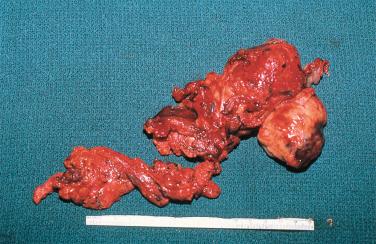
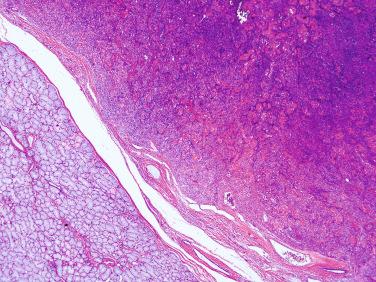
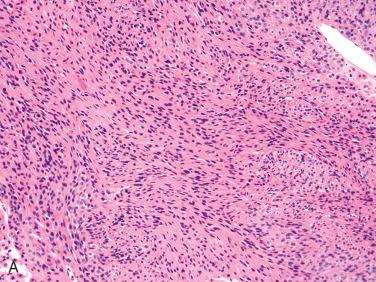
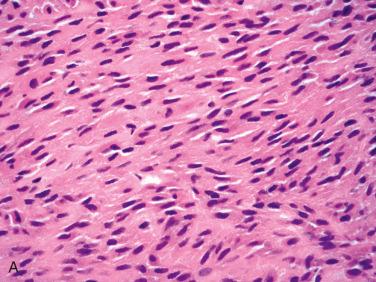
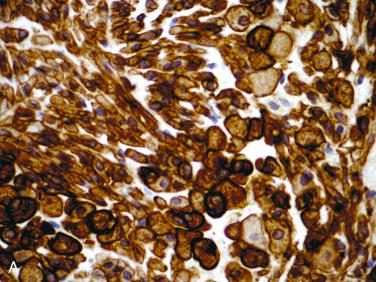
Synonyms: Myoepithelial adenoma; benign myoepithelial tumor
Accounts for approximately 2% of all salivary gland neoplasms
No gender predilection; occurs over a wide age range but is most commonly seen in the third to sixth decades of life
Although all salivary gland sites may be affected, the most common site of involvement is the parotid gland.
Second most common site is the palate (hard and soft palate)
Other sites may include the submandibular gland and oral minor salivary glands (e.g., retromolar region, upper lip).
Most commonly present as a slow-growing, painless mass
Smears show bundles of uniform-appearing spindle-shaped, epithelioid/plasmacytoid, and stellate cells in sheets and dissociated forms:
Nuclear atypia is absent or limited in extent.
Occasionally, nuclear grooves intranuclear inclusions may be identified.
Glandular/tubular structures not identified
By May-Grünwald-Giemsa staining most of the cells have a reddish cytoplasm.
Red to purple, myxoid matrix appearing as scanty fibrillar substance and as globules surrounded by tumor cells may be present and may suggest a diagnosis of adenoid cystic carcinoma.
Well-demarcated, smooth, and bosselated solid lesion with a tan-white to tan-yellow appearance measuring up to 5 cm in diameter
Encapsulated cellular neoplasm composed of spindle-shaped, plasmacytoid (hyaline) cells, epithelioid or clear cells:
Capsule varies in thickness but often is thin.
Tumors originating in minor salivary glands are circumscribed but not encapsulated.
Growth patterns may include:
Fascicular
Solid
Trabecular
Reticular:
Uncommon pattern characterized by interconnecting cords with associated loose vascularized stroma (reticulated)
Majority of myoepitheliomas are of spindle cell type:
Spindle-shaped cells have uniform, centrally located nuclei with dispersed nuclear chromatin and eosinophilic granular to fibrillar-appearing cytoplasm
Growth patterns include fascicular or swirling.
Other cell types may include:
Plasmacytoid (hyaline) cells:
Polygonal with round to oval pyknotic-appearing nuclei, which may be eccentrically located as a result of the accumulation of eosinophilic hyaline material in the cytoplasm
A paranuclear clear zone (hof) and methyl green pyronine staining are not present.
Growth patterns include islands, sheets, cords, or isolated cells
Tumors composed predominantly of plasmacytoid myoepithelial cells occur in the palate.
A mucinous stroma may be seen in the plasmacytoid cell type.
Epithelioid cells:
Large polygonal cells with central nuclei and eosinophilic cytoplasm
Growth patterns include reticular, trabecular solid
Hyalinized stroma may be present and in conjunction with the tumor cells showing narrow interconnecting cords (so-called reticular pattern); confusion with the tubulo-trabecular type of basal cell adenoma may arise.
Clear cells:
Abundant clear cytoplasm rich in glycogen (diastase-sensitive, PAS-positive)
Oncocytic cells:
Characterized by presence of abundant granular eosinophilic-appearing cytoplasm
Mucinous cells referred to as mucinous variant of myoepithelioma:
Characterized by cells with abundant eosinophilic to foamy-appearing grayish-blue cytoplasm
Contain abundant intracellular mucin material
For all cell types, mild to moderate cellular pleomorphism may be seen but increased mitotic activity and necrosis are uncommon.
Stroma may be hyalinized and/or appear myxomatous.
Tyrosine-like crystals may be present.
Immunohistochemistry:
Cytokeratins (pancytokeratin, CK14), EMA, p63, calponin, S100 protein, smooth muscle actin, smooth muscle myosin heavy chain, glial fibrillary acidic protein (GFAP), vimentin, EMA, and muscle-specific actin variably positive
Desmin, thyroglobulin, TTF-1, CD10, and renal cell carcinoma marker negative
Electron microscopy:
Epithelial features in the form of desmosome, tight junction
Myoid features in the form of intracytoplasmic myofilaments with focal densities, pinocytotic vesicles
Molecular biology:
Typically lacks PLAG1 rearrangement:
At least one study reported PLAG1 immunohistochemical staining in 8 myoepitheliomas
Lacks EWSR1-POU5F1 or EWSR1-PBX1 gene fusion seen in soft tissue myoepithelial tumors
Structural alterations in chromosomes 1, 9, 12, and 13:
t(1;12)(q25;q12)
del(9)(q22.1q22.3)
del(13)(q12q22)
Myoepithelial-predominant pleomorphic adenoma:
Although myoepithelial cells predominate, residual foci of pleomorphic adenoma in the form of myxochondroid stroma are present.
Basal cell adenoma
Myoepithelial carcinoma
Epithelial-myoepithelial carcinoma
Extracranial meningioma
Peripheral nerve sheath tumors (i.e., neurilemmoma and malignant schwannoma)
Smooth muscle tumors (i.e., leiomyoma and leiomyosarcoma)
Extramedullary plasmacytoma
Spindle cell squamous carcinoma
For clear cell dominant or exclusive tumors, the differential diagnosis may include metastatic renal cell carcinoma or thyroid carcinoma.
Complete surgical excision is the preferred treatment and should include a portion of surrounding uninvolved tissue; if appropriate, a superficial parotidectomy should be performed.
Local recurrence is related to inadequate excision.
There is no relationship between cell type (e.g., spindle, plasmacytoid, epithelioid, clear) and prognosis.
Malignant transformation is rare and occurs in the setting of a long-standing tumor and/or multiply recurrent tumor.
Primary myoepithelial tumors of soft tissues are uncommon.
Classification includes:
Benign neoplasm (myoepithelioma)
Malignant neoplasms (myoepithelial carcinoma); see Myoepithelial Carcinoma later in chapter
As compared with their salivary gland counterpart:
A higher proportion of myoepithelial tumors of soft tissues are malignant.
Unlike salivary gland myoepithelial carcinoma, in which a majority arise in association with a pleomorphic adenoma (i.e., myoepithelial carcinoma ex pleomorphic adenoma), this occurrence is rare relative to soft tissue myoepithelial carcinoma, the majority of which occurs as a de novo malignancy.
Identification of EWSR1-POU5F1 or EWSR1-PBX1 gene fusion
Subset of cutaneous and superficial soft tissue myoepithelial tumors display distinct ductal component, closely resembling pleomorphic adenomas of salivary gland:
Recurrent PLAG1 rearrangement by FISH detected in cutaneous and benign soft tissue myoepithelial tumors, majority with abundant tubulo-ductal differentiation
Leukemia inhibitory factor receptor (LIFR)-PLAG1 fusion confirmed by FISH in one soft tissue myoepithelial tumor with tubular formation
Findings indicate that subset of cutaneous and soft tissue myoepithelial tumors appear genetically linked to salivary gland counterparts with frequent PLAG1 gene rearrangements and occasionally LIFR-PLAG1 fusion.
Definition: Rare neoplastic process of salivary glands with histologic similarities to mammary gland fibrocystic disease.

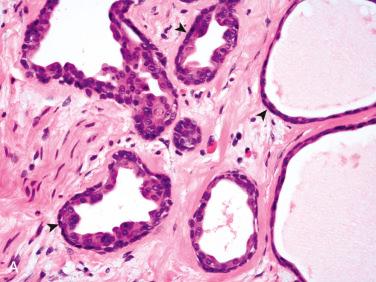
NOTE: Reported presence of associated/superimposed foci of carcinoma in situ, invasive carcinoma, local recurrence, and clonality support classification as true neoplastic lesion rather than nonneoplastic proliferation as initially considered.
Uncommon lesion
More common in women than in men; occurs over wide age range from the first to the tenth decades of life with a mean of 33 years
Most common site of occurrence is parotid gland:
Much less often submandibular gland and intraoral salivary minor glands are affected.
Rare cases reported in other sites, including sinonasal tract
Patients present with a slow-growing asymptomatic mass; rarely, pain and/or a “tingling” sensation have been described.
Majority of cases present as a de novo process but a few cases have been described in association with recurrent pleomorphic adenomas or recurrent chronic parotitis
Familial occurrence reported in two sisters, suggesting genetic predisposition
Aspirate characterized by flat cohesive sheets of epithelial cells with moderate amounts of finely granular oncocytic cytoplasm and enlarged round nuclei with indistinct nucleoli.
Some epithelial groups form glandular structures with lumens.
Background may contain small amounts of delicate mucoproteinaceous material.
Markedly vacuolated cells as well as cells with apocrine change manifested by well-defined apical snouting may be identified.
The lesions usually appear as a single, well-circumscribed mass but may be multinodular, ranging in size from 1 to 5 cm in greatest dimension.
On cut section the lesions are rubbery to firm with a pale, glistening appearance.
Small cystic foci may be apparent on gross examination.
Most lesions appear as well-circumscribed and partially encapsulated nodules with a peripheral rim of normal salivary parenchyma.
Characterized by presence of abundant sclerotic collagenous tissue containing lobular proliferations of epithelial cells with ductal/tubular and acinous differentiation:
Ducts vary in size from cystically dilated spaces to small ductules.
Epithelial lining includes simple columnar to flattened cuboidal epithelium.
Hyperplasia of ductal and acinar epithelial cells can be identified with interconnecting bridges or anastomosing cords creating a cribriform pattern, as well as papillary growth.
Some cells may demonstrate the presence of intensely eosinophilic cytoplasmic granules and/or hyaline globules:
Considered highly characteristic although not absolutely pathognomonic
In addition, apocrine metaplasia, mucous cells, squamous cells, and sebaceous-like cells can be present.
Degenerative changes that can be found include:
Partial or completely denuded epithelium of the cystic ducts with replacement by foamy (xanthomatous) macrophages
Cytoplasm of the epithelial cells may be replaced by abundant pale, reticulated cytoplasm, creating a balloon-like appearance resembling sebaceous cells.
Intraluminal epithelial proliferation may show a spectrum of alterations ranging from nondescript with mild atypia to higher degrees of epithelial dysplasia, including moderate to severe, that at times border on ductal carcinoma in situ (DCIS):
DCIS is histologically identical to mammary ductal carcinoma in situ, and similar to the breast lesions, the salivary gland lesions retain a myoepithelial cell layer (see below).
To date, single case of invasive carcinoma arising in SPA reported:
Invasive component composed of isolated pleomorphic cells with eosinophilic cytoplasm, large nuclei, and prominent nucleoli diffusely infiltrating normal salivary gland and with focal entrapment of normal salivary ducts
Carcinoma in situ identified adjacent to invasive carcinoma
Histochemistry:
Granules in cells with acinar differentiation show diastase-resistant PAS-positive material.
These granules are mucicarmine negative, but faint mucicarmine-positive staining can be seen in scattered duct-lining cells.
Immunohistochemistry :
Tubuloacinar cells are immunoreactive for cytokeratin, CEA, BRST2, progesterone receptor (80%), and estrogen receptor (20%).
Absence of HER-2
Myoepithelial cells reactive with variety of myoepithelial cell markers, including p63, calponin, S100 protein, and smooth muscle actin
Cytogenetics and molecular genetics:
PCR analysis of patterns of X-chromosome inactivation using human androgen receptor (HUMARA) locus has shown monoclonal population of cells indicative of monoclonality.
Polycystic (dysgenetic) disease (see Chapter 19 ):
Lobular collection of cystic ducts frequently with apocrine metaplasia
Unlike SPA, polycystic disease is usually:
Bilateral
Involves entire gland
Shows no acinar proliferation and has minimal fibrosis and inflammation
Sclerosing sialadenitis:
Shows similarities to SPA including presence of fibrosis and inflammation
In contrast to SPA, fibrosis is not nodular nor are xanthomatous cells seen in association with the duct ectasia.
Complete surgical resection is preferred treatment:
Facial nerve sacrifice not indicated
Recurrence of the lesion may occur following incomplete excision:
30% recurrence rate reported in some studies.
Prognosis is very good with the caveat that until longer follow-up becomes available in these patients the biologic behavior may not be completely known.
To date, no reported metastatic disease or death due to disease reported
Definition: Rare benign epithelial tumor characterized by its predominantly cystic (unicystic, multicystic) growth and variable appearing benign epithelial-lining cells.
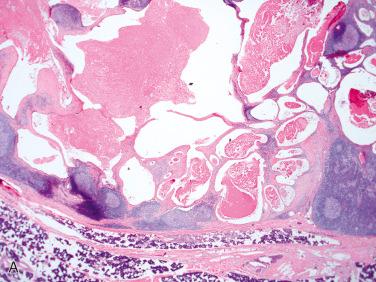
Synonym: Cystic duct adenoma
Rare tumor type
More common in women than in men; occurs over a wide age range from the second to ninth decades but most common in the sixth decade of life; rarely occur in the first two decades of life.
Majority occurs in minor salivary glands, including:
Lips > cheek > palate
Slightly less than half (approximately 45%) occur in the parotid gland
Minority of cases (less than 10%) occur in submandibular gland.
Majority present as slowly growing, painless masses; minor salivary gland lesions appear as mucosa-covered smooth nodules resembling mucoceles.
On cut section these tumors show multiple, variably sized (small) cysts surrounded by salivary gland parenchyma; occasionally a single large cyst may be present.
Tumor size in major glands varies; typically measure less than 1 cm in minor salivary gland sites
Circumscribed lesions that may or may not be encapsulated:
Presence of a capsule is variably seen
If fibrous capsule is present, it may completely or incompletely encapsulate lesion.
Characterized by presence of a unicystic or multicystic lesion:
Cysts vary in size.
Most are multicystic with cysts separated by a limited amount of intervening dense, fibrous stroma.
Intervening stroma may be absent.
Patchy collections of chronic inflammatory cells are often present.
Epithelial lining cells include single layer of cuboidal to columnar epithelium with bland nuclei lacking atypical features and absent mitotic figures.
Tumors with two or more cell layers thick may be present but cytologic atypia is absent.
Other cell types that may be seen include mucous, oncocytic, sebaceous, and squamous cells:
Usually, when these cell types are seen they are scattered and admixed with the cuboidal or columnar cells.
Rarely, one of these cell types, in particular mucous cells and oncocytic cells, may predominate.
Unicystic lesions often have luminal papillary growth:
Papillae vary from thin to widened and ramifying projections.
Fibrovascular cores are present.
Mucinous cystadenoma:
Includes columnar cells with basally located nuclei and intracytoplasmic mucin-positive material
Combination of epidermoid, intermediate, and mucous cells not identified
Cystadenomas associated with oncocytic features and papillary growth are termed oncocytic papillary cystadenoma:
Often seen in association with minor salivary glands, in particular the larynx (see Section 5)
Usually composed of a single epithelial layer
Other findings may include:
Cystic spaces containing eosinophilic fluid that may be inspissated
Admixed epithelial cells and inflammatory cells may be present.
Intraluminal psammomatoid concretions and/or crystalloids may be identified.
Prominent solid, extraluminal growth is unusual and, if present, should be suspicious for a malignant neoplasm.
Cystic lesions associated with duct obstruction:
Such lesions include duct ectasia, as well as salivary duct cyst.
Typically, duct obstruction primarily affects submandibular gland
Secondary changes to duct obstruction include fibrosis, acinar atrophy, squamous metaplasia, chronic inflammation, and periductal hyalinization.
In comparison with cystadenoma, the ectatic or cystic ducts in obstructive lesions are widely separated, may be seen connected to or tracking to the obstructed duct, and usually lack the greater cytologic variability of the intraluminal epithelial proliferation seen in cystadenoma.
Warthin tumor:
Characteristic bilayered epithelial layer and prominent dense lymphoid stroma with germinal centers of Warthin tumor not seen in cystadenoma, including papillary oncocytic cystadenoma
Intraductal papilloma:
Almost invariable a unicystic lesion
Occurs in association with a dilated salivary gland duct
Intraluminal papillations are more complex and numerous than papillae of cystadenoma.
Cystadenocarcinoma:
Presence of invasive growth differentiates cystadenoma from cystadenocarcinoma.
Mucoepidermoid carcinoma, low-grade:
May share overlapping features with cystadenoma
Noncystic epithelial component of mucoepidermoid carcinoma includes an admixture of mucous, epidermoid, intermediate cells, which are absent in cystadenoma
Invasive growth, a feature often (but not always) seen in mucoepidermoid carcinoma absent in cystadenoma
Polycystic (dysgenetic) disease:
Presence of diffuse involvement of the affected gland, apocrine lining epithelial cells and spheroliths seen in polycystic (dysgenetic) disease assists in differentiating it from cystadenoma.
Complete (conservative) surgical resection is curative.
Recurrent tumor and malignant transformation rarely occur.
Definition: Group of uncommon benign epithelial salivary gland neoplasms with unique histologic features allowing for easy identification.
Classification includes three types:
Sialadenoma papilliferum
Intraductal papilloma
Inverted ductal papilloma
Definition: Benign salivary gland tumor characterized by exophytic (papillary) and endophytic epithelial proliferation of mucosa or salivary duct origin.
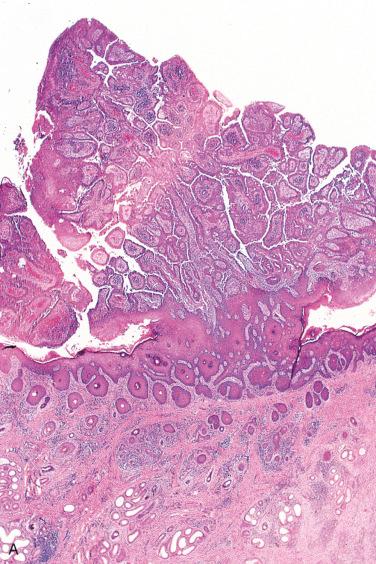
Synonym: So named because of its similarity to the cutaneous syringocystadenoma papilliferum
Uncommon tumor
More common in men than in women; occurs over a wide age range but is most frequently seen in the sixth to seventh decades of life.
Most common site of occurrence is the palate (greater than 80%), particularly at junction of the hard and soft palates.
Other minor salivary glands sites of involvement include buccal mucosa, retromolar region, tonsillar pillar, lip, and nasopharynx (adenoids).
Major gland involvement is rare and in major glands parotid gland is most commonly affected.
Usually presents as an asymptomatic (painless) lesion generally discovered incidentally; clinical appearance often mistaken for a papilloma; duration of symptoms may be from months to years.
Origin is disputed; evidence supports salivary gland excretory duct rather than intercalated duct origin.
Well-circumscribed, papillary or verrucoid, round to oval, tan-pink–appearing lesion measuring from a few millimeters to as large as 7.0 cm
Base of lesion is broad or pedunculated.
Exophytic and endophytic proliferation of surface and ductal epithelium
Surface has papillary to verrucoid growth composed of a stratified squamous epithelium with a fibrovascular connective tissue core; acanthosis and parakeratosis of the squamous epithelium can be seen.
Merging with surface epithelium and lying immediately subjacent to squamous epithelium is an endophytic proliferation of ductal epithelium forming dilated and tortuous structures:
An abrupt transition from stratified squamous epithelium covering the mucosal papillary proliferation to columnar epithelium lining the ducts identified
Glandular component is unencapsulated.
Glandular component is composed of rounded or elongated and dilated ductlike structures.
In deeper portions ductal structures have papillary luminal projections and microcysts.
Absence of encapsulation and presence of poor circumscription at the base of the lesion may simulate invasive growth and be mistaken for a malignancy.
Ductal epithelium composed of two cell layers:
Outer or luminal layer: tall columnar cells with an eosinophilic granular cytoplasm
Inner or basal cell: cuboidal cells with an eosinophilic granular cytoplasm
Mucous cells can be seen admixed and interspersed throughout the ductal cells and in the squamous component; oncocytic cells may also be seen.
Chronic inflammatory cell infiltrate predominantly composed of plasma cells admixed with mature lymphocytes is present within the lamina propria of the squamous mucosal component and in the stroma of the glandular component.
Immunohistochemistry:
Ductal luminal cells:
Cytokeratins (AE1/AE3, CK7, CK19, CAM5.2), CEA, EMA, S100 protein positive
Basal cells:
CK7, CK14, S100 protein, and vimentin positive
Dendritic (Langerhans) cells identified within the epithelial component stain for S100 protein and CD1a positive.
Papilloma of surface epithelial origin
Inverted ductal papilloma
Warty dyskeratoma
Verrucous carcinoma
Mucoepidermoid carcinoma, low grade
Complete conservative surgical excision is the preferred treatment and is curative.
Recurrence rarely occurs.
Rare examples of malignant transformation reported, including:
Epithelial-myoepithelial carcinoma
Mucoepidermoid carcinoma
Carcinoma in situ
Definition: Benign salivary gland neoplasm characterized by unicystic duct dilatation of luminal papillary proliferation arising from a segment of interlobular or excretory duct.
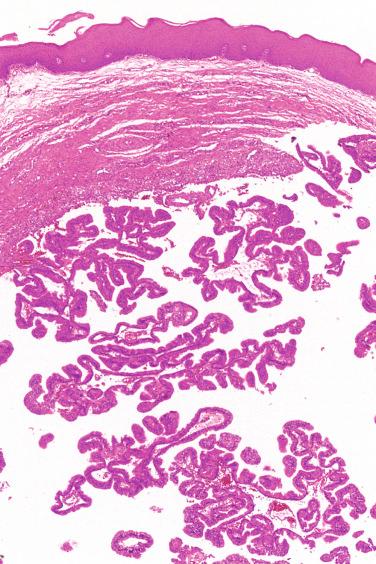
Uncommon tumor
No gender predilection; affects primarily adults, occurring in the fourth through seventh decades of life
Intraoral minor salivary glands most frequently involved:
Buccal mucosa and lips are most commonly affected.
Other sites of occurrence include floor of mouth, soft palate, and tongue.
Involvement of major glands is rare.
Symptoms relate to a painless, well-delineated, and solitary (submucosal) mass.
Well-circumscribed, mucosa-covered nonulcerated nodule measuring from 0.5 to 2 cm in diameter.
Cut section reveals a unicystic lesion containing friable tissue.
Unicystic cavity lined by one or two layers of cuboidal or columnar epithelium with eosinophilic cytoplasm, which give rise to numerous papillary fronds filling the cavity; papillations are covered by a similar epithelium.
Cytologic atypia is absent; no significant increase in mitotic activity
Mucocytes in form of goblet cells are seen admixed within the ductal epithelium
Papillations have a thin fibrovascular connective tissue core.
Continuity of papillary projections to cyst wall is present but depending on the sections the papillae may not be seen in continuity to the cyst wall and appear to float within the lumen.
Epithelial component is confined to cyst cavity and there are no extensions into the adjacent stromal tissue.
Inverted ductal papilloma
Papillary cystadenoma
Low-grade papillary adenocarcinoma of the nasopharynx
Complete conservative surgical excision is the preferred treatment and is curative.
Definition: Benign salivary gland neoplasm characterized by a luminal papillary projection occurring in the terminal portions of excretory ducts arising at the junction of a salivary gland duct and oral mucosal surface epithelium with a characteristic inverted (endophytic) growth.
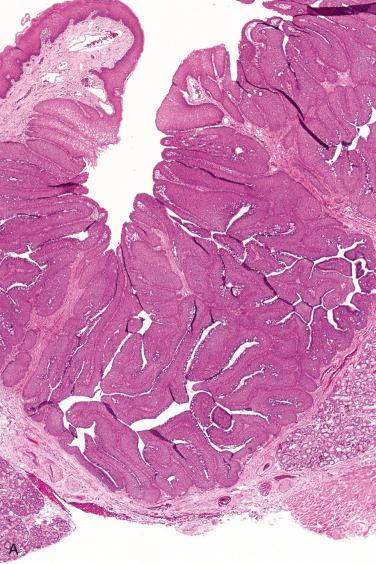
Synonym: Epidermoid papillary adenoma
NOTE: This minor salivary gland tumor shares histologic features with sinonasal (Schneiderian) inverted papilloma but does not share in the biologic behavior of the sinonasal (Schneiderian) inverted papilloma.
Rare neoplasm
No gender predilection; occurs primarily in adults over a wide age range but is most frequently seen in the sixth decade of life
Most common sites of occurrence include:
Lower lip and the buccal (vestibular) mucosa
Other sites of involvement include the upper lip, floor of mouth, and soft palate.
Generally asymptomatic and presents as a slow-growing painless, nodular submucosal swelling
Submucosal firm nodule measuring up to 1.5 cm in diameter; a small surface pore may be seen, which is contiguous with the lumen of the tumor.
Unencapsulated but well-demarcated, endophytic epithelial growth composed of thick, bulbous proliferations that are contiguous with but not protruding from the surface epithelium; communication with the surface by a narrow opening may be seen.
Consists of basaloid and squamous/epidermoid cells between which mucous cells and microcysts may be interspersed; cytologic atypia is absent and there is no significant increase in mitotic activity.
Luminal surface epithelium composed of cuboidal or columnar cells with a papillary appearance
Tumor grows downward and appears to fill a luminal cavity:
Endophytic growth is “pushing” into the submucosa rather than demonstrating invasion or infiltration.
Histochemistry:
Mucous cells stain positively with mucicarmine and are diastase resistant, PAS positive.
Inverted papilloma
Sialadenoma papilliferum
Mucoepidermoid carcinoma
Conservative but complete local excision is the preferred treatment and is curative.
Rare to uncommon benign epithelial neoplasms of salivary glands include:
Striated duct adenoma
Intercalated duct adenoma
Lymphadenoma (nonsebaceous)
Keratocystoma
Lipoadenoma
Adenofibroma
Apocrine adenoma
Salivary gland anlage tumor
Definition: Unilayered ductal tumor that recapitulates normal striated ducts.
Rare tumor type with very few reported cases
Most common site of occurrence is parotid gland
May occur less often in minor salivary glands (palate)
Present as a palpable mass
Well-circumscribed to encapsulated lesion ranging in size from 0.5 to 3.0 cm
Composed of closely apposed small ducts with minimal intervening stroma admixed with cystic ductal spaces that may include:
Prominent areas with cystic changes containing colloid-like luminal contents with scalloped edges reminiscent of thyroid parenchyma
Focal cysts
Absence of cystic spaces
Ductal epithelial cells:
Single layer of cuboidal to columnar eosinophilic cells with bland nuclei, eosinophilic cytoplasm, and prominent cell membranes similar to striations of normal striated ducts:
Eosinophilic intranuclear inclusions may be seen.
Focal clear cell cytoplasmic change may be present.
Absence of epithelial “beading” pattern with abundant stroma seen in canalicular adenoma
Absence of chondromyxoid stroma, basal lamina-like material
Absence of mitotic activity and necrosis
Absence of visible bilayering composed of ductal cells surrounded by basal or myoepithelial cells:
In contrast, normal excretory and intercalated ducts contain diffuse bilayering with basal or myoepithelial markers.
Psammoma bodies and an associated adipocytic component may be identified.
Immunohistochemistry:
Keratins (CK7, pankeratin) consistently present
S100 protein in >80%
CK5/6 (75%)
Generally devoid of myoepithelial cells:
Smooth muscle actin (SMA) negative
Isolated cells may be p63 positive
Pattern identical to striated ducts
Focal calponin and smooth muscle myosin heavy chain may be present, forming incomplete rim around ducts
Thyroglobulin and TTF1 negative
Highly vascular lesions with numerous small capillaries, some containing large ecstatic staghorn vessels
Complete resection curative
No recurrence or metastases
Definition: Rare benign neoplasm of intercalated duct epithelium. See discussion in Chapter 19 on intercalated duct lesions.

Presence of discrete, rounded, partially to completely encapsulated nodules with well-defined contours
Fibrous capsule may vary in thickness and may contain entrapped, irregular-appearing ducts.
Composed of intercalated ducts lined by single layer of cuboidal to columnar cells with small round nuclei and eosinophilic to amphophilic cytoplasm:
There is an absence of nuclear pleomorphism or increased mitotic activity.
Minimal intervening stroma present
Occasionally acinic cells may be interspersed among the ductular structures.
Immunohistochemistry:
Luminal cells reactive for cytokeratin (CK7), DOG1 (apical and membranous), S100 protein, and lysozyme
Basal/myoepithelial markers including p63, calponin, CK14, or smooth muscle actin highlight thin layer of myoepithelial cells around ducts:
Basal/myoepithelial cells are indistinct by light microscopy.
Definition: Rare benign tumor that is circumscribed to encapsulated and composed of epithelial nests including glands with associated prominent lymphocytic component but without islands of sebaceous cells (unlike sebaceous lymphadenoma).
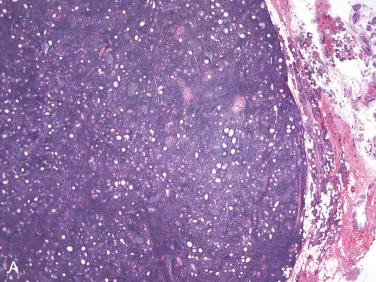
Uncommon tumor type but more common than sebaceous lymphadenoma
No gender predilection; primarily disease of adults
Most commonly arises in parotid gland:
Less commonly arises in submandibular gland
Solid or cystic epithelial tumor islands:
Solid foci may show trabecular growth or tubules surrounded by a basement membrane–like material.
Cystic foci may contain proteinaceous material.
Papillary architecture may occasionally be seen.
Cells types include squamous cells in the solid nests, cuboidal to columnar cells lining cysts, but an absence of sebaceous cells.
Cellular components are rather bland, lacking atypical features, significant increase in mitotic activity, and an absence of necrosis.
Epithelial components are intimately associated with a lymphoid stroma that includes a dense mature lymphocytic cell infiltrate with identifiable lymphoid follicles; this lymphoid component is believed to represent the tumor-associated lymphoid stroma, a finding that can be seen in association with other salivary gland tumors.
Absence of atypical features, mitotic activity, and necrosis assists in differentiating lymphadenoma from a malignancy (either a primary salivary gland carcinoma or metastatic adenocarcinoma).
Surgical excision is curative.
Definition: Benign salivary gland tumor composed of multiple cystic structures and solid nests of purely squamous cells.
Rare tumor type
No gender predilection; occurs over wide age range, including pediatric and adult ages
To date, all cases limited to parotid gland
Present as slowly growing tumors
Cut surface shows multilocular cystic lesions filled with keratin materials.
Histologically:
Multicystic spaces and solid epithelial islands containing lamellated-appearing keratin
Lined by stratified squamous epithelium with keratinization, including orthokeratosis and parakeratosis but absence of granular layer
Stratification of epithelium always regularly oriented from the outer basal to the inner keratotic cell layer
Basal cell layer demarcated by basement membrane from surrounding inflamed fibrous stroma
Focally, outer layer shows bud-like protrusions.
Solid squamous cell islands surrounded by basement membrane enveloped within collagenous stroma may be present.
Cystic and solid structures randomly distributed without definite lobular architecture
Lesional cells composed of uniform, bland nuclei and abundant eosinophilic cytoplasm
Scattered mitotic figures may be seen usually limited to outer epithelial layer; atypical mitoses not present
Foreign-body giant cell reaction to keratin debris may be present.
Immunoreactivity for cytokeratins (AE1/AE3, CK5/6, CK14) but negative for CAM5.2, S100 protein, actin, and calponin
Complete surgical resection is curative.
No recurrences reported
Definition: Benign neoplasm composed predominantly of mature adipose tissue admixed with adenomatous elements.
Synonym: Sialolipoma
More common in men than in women; occurs over a wide age range from third to eighth decades
Arises primarily in parotid gland:
Less often may occur in submandibular gland and oral minor salivary glands
Solitary and well-circumscribed with light brown to yellow appearance on cut section
Histologically, composed of an admixture of cells, including:
Mature adipose tissue:
Usually dominates, representing more than 90% but reported in as little as 5% of a given tumor
Benign salivary gland epithelial parenchymal components:
Sharply demarcated from fat
Composed of ducts and acini:
Ductal dilatation may be present.
Extensive oncocytic cell population often present
Other cell types may include sebaceous cells and squamous cells.
Irrespective of cellular components there is an absence of cytologic atypia.
Other common features include the presence of serous acini, ductal elements, sebaceous glands, and a patchy chronic inflammation.
Complete surgical resection is curative.
No recurrences reported
Rare tumor type of major and minor salivary glands
Composed of closely packed small glands lined by cells with apocrine features
Extremely rare tumor type
Composed of admixture of adenomatous glands and cellular spindle cell stroma:
Spindle cells are CD34 positive but negative for p63, S100 protein, and actin
Definition: Benign tumor with mixed epithelial and mesenchymal elements recapitulating early stages in the embryology of salivary glands between fourth and eighth weeks of development.
Synonym: Congenital pleomorphic adenoma
See Section 3, Pharynx, for detailed discussion including illustrations.
Sebaceous tumors of salivary glands are rare and are thought to originate from sebaceous cells or sebaceous glands found in salivary glands.
Normal sebaceous cells or glands can be found in the oral mucosa, parotid gland, and submandibular gland; sebaceous cells can also be found in intra- and periparotid lymph nodes.
Salivary gland sebaceous cells or glands are histologically similar to their cutaneous counterparts.
Benign sebaceous tumors of salivary glands include:
Sebaceous adenoma
Sebaceous lymphadenoma
Definition: Rare benign epithelial salivary gland tumor that is encapsulated with solid and cystic growth and composed of cells with sebaceous differentiation, as well as squamous differentiation.
Rare tumor accounting for 0.1% of all salivary gland tumors.
More common in men than in women; occur over a wide age range from the third to tenth decades of life, and a mean in the sixth decade of life
Most common site of occurrence is parotid gland
Other sites of occurrence include the submandibular gland and oral cavity:
Sites of involvement in oral cavity include the buccal mucosa and posterior mandibular region.
Given the presence of sebaceous cells in oral mucosa (unassociated with minor salivary gland), a definitive minor salivary gland origin cannot be confirmed.
Generally asymptomatic and presents as a slow-growing, painless, firm mass; duration of symptoms may be from months to years.
Well-circumscribed, solid and cystic, tan-white– to yellow-appearing lesion ranging up to 3.0 cm in greatest dimension
Encapsulated tumors:
Capsule may be complete or partial
In relationship to cysts capsular irregularities are present so that a well-defined capsule is not identified.
Composed of solid nests or islands as well as cysts surrounded by fibrous stroma
Neoplastic cells often predominated by squamous cells with associated sebaceous cells; however, sebaceous cells may predominate:
Sebaceous cells are characterized by:
Vacuolated or multivacuolated cytoplasm
Nuclei that are centrally located and scalloped due to lipid imprints
Instead of solid nests, some examples have microcystic foci of closely associated ductal or cyst-like structures lined by squamous and sebaceous cells, and separated by a fibrous stroma
Other cellular elements that can be seen include mucous cells and oncocytic cells.
Cellular components lack atypical features with no significant increase in mitotic activity and absent necrosis.
Fibrous stroma contains a variable amount of chronic inflammatory cells:
Foreign body giant cell reaction, lipogranuloma formation and collections of foamy histiocytes may be identified.
Histochemistry:
Sebaceous cells contain lipid that can be stained by oil red O on frozen section.
Epithelial mucin stains are negative.
Immunohistochemistry:
Sebaceous cells are EMA positive.
Sebaceous lymphadenoma
Sebaceous carcinoma
Mucoepidermoid carcinoma
Conservative but complete surgical resection is curative.
Unlike their cutaneous counterparts, salivary gland sebaceous adenomas not associated with increased risk of visceral carcinomas as may occur in Muir-Torre syndrome
Definition: Rare benign tumor that is circumscribed to encapsulated composed epithelial nests and islands of sebaceous cells surrounded by lymphocytes, including lymphoid follicles.
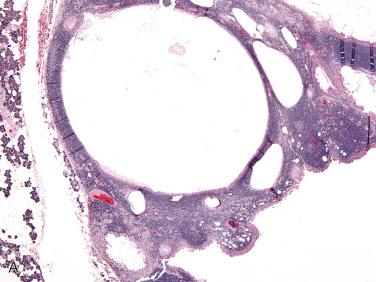
Rare tumor
No gender predilection; occurs primarily in the sixth to eighth decades of life
Majority (more than 90%) occur in parotid gland or in periparotid region
Other much less sites of occurrence include anterior midline neck and oral cavity.
Generally asymptomatic presenting as slow-growing, painless mass; duration of symptoms may be from months to years.
Association with Warthin tumor and basal cell adenoma, membranous type reported
Similar to Warthin tumor, the suggestion has been made that sebaceous lymphadenoma may arise in salivary gland inclusions within a lymph node; however, there is no definitive proof that this tumor is arising in a lymph node but rather represents the so-called tumor-associated lymphoid stroma (TALP), a phenomenon that can be seen in association with other salivary gland tumors (e.g., acinic cell carcinoma, mucoepidermoid carcinoma, others).
Fine-needle aspiration biopsy:
Smears show clusters of epithelial cells in background of abundant lymphoid cells, macrophages, and abundant proteinaceous materials.
Predominant epithelial cells are large polygonal cells with abundant cytoplasm filled with multiple, uniform, small, and clear vacuoles, ill-defined cytoplasmic borders, and small centrally located round nuclei with finely granular chromatin, conspicuous nucleoli, and indented nuclear membranes.
Other cells include polygonal or flat cells with less or more dense cytoplasm, indistinct cell borders, and round or oval small nuclei with smooth nuclear membranes corresponding to basaloid cells.
Large three-dimensional clusters of nonkeratinized squamous cells with oval nuclei containing evenly distributed chromatin, and scant to moderate dense cytoplasm arranged in “stream of fish” pattern
Rare granulomas and cystic contents (degenerated cells, inflammatory cells, macrophages, and abundant granular debris/proteinaceous material) may also be seen.
Well-circumscribed to encapsulated, solid to multicystic, yellow- to yellow-white–appearing lesion ranging up to 6.0 cm in greatest dimension
May have a complete capsule but may also be partially encapsulated or unencapsulated:
Unencapsulated tumors have delineated or circumscribed periphery that may abut but does not infiltrate adjacent salivary gland parenchyma or connective tissues.
Consists of islands and ductlike structures composed of squamous cells and sebaceous cells; cuboidal, columnar, and oncocytic cells may also be present
Cysts may also be identified lined by admixture of squamous, sebaceous, and columnar cells; small intraluminal nodular excrescences may be present.
Epithelial component intimately associated with dense lymphoid component:
Well-developed lymphoid follicles can be seen in many cases.
Generally devoid of myoepithelial cells
Foreign body giant cell reaction and collections of histiocytes may be identified in stroma, representing secondary reaction to extravasated sebum.
Cellular epithelial components lack atypical features with no significant increase in mitotic activity and absent necrosis.
Histochemistry:
Sebaceous cells contain lipid that can be stained by oil red O on frozen section.
Epithelial mucin stains are negative.
Duct epithelial cells may show mucicarminophilia.
Immunohistochemistry:
Sebaceous cells are EMA positive.
Epithelial cells express basal cell markers including p63, 34BE12, and/or CK5/6.
Luminal glandular cells express CK7.
Lymphoid stroma is reactive for both B- and T-cell markers.
No evidence of HPV, EBV, and HHV-8
Sebaceous adenoma
Lymphadenoma, nonsebaceous, of salivary gland origin:
Similar to sebaceous lymphadenoma but lacks sebaceous cell component
See previously in chapter for more complete discussion.
Warthin tumor
Lymphoepithelial sialadenitis
Mucoepidermoid carcinoma
Lymphoepithelial carcinoma
Metastatic adenocarcinoma to periparotid or intraparotid lymph node
Conservative but complete surgical resection is curative.
Rarely, single cases of malignant transformation to sebaceous carcinoma and basal cell adenocarcinoma reported
Benign mesenchymal tumors of salivary glands are uncommon, accounting for approximately 2% to 5% of all major salivary gland neoplasms.
Mesenchymal neoplasms of salivary glands are rare:
In first 2 decades of life mesenchymal tumors represent a significant proportion of all parotid gland tumors and may in fact be more common than epithelial tumors.
Hemangioma and lymphangioma most common
Benign mesenchymal tumors of salivary glands much more common than salivary gland sarcomas
Benign mesenchymal tumors account for less than 5% of all salivary gland tumors
Parotid gland is most common site of occurrence:
>95% arise in parotid gland
Although virtually any mesenchymal tumor can occur, among all salivary gland mesenchymal tumors the most common are of vascular origin, including hemangiomas.
Much less common benign mesenchymal tumors that may be seen in salivary glands include:
Lymphangioma
Lipoma
Benign peripheral nerve sheath tumors (i.e., schwannoma, neurofibroma)
Solitary fibrous tumor
Nodular fasciitis
Giant cell tumor
Definition: Benign vascular tumor of infancy.
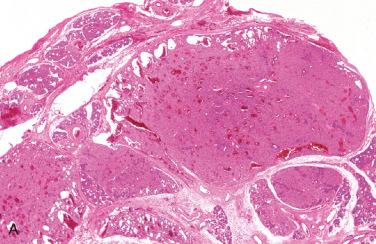
Synonyms: Benign (infantile) hemangioendothelioma; congenital or juvenile hemangioma; cellular hemangioma; immature capillary hemangioma
Common benign vascular tumor of infancy (affecting approximately 4% of children)
Approximately 60% occur in head and neck.
Most common in the skin and subcutis
May occur in other locations, including salivary (parotid) glands
Represents most common salivary gland tumor in pediatric population, accounting for greater than 90% of parotid gland tumors in children less than 1 year old
More common in females than in males; may occur over a wide age range but most frequently seen in the first decade of life
Almost exclusively involves parotid gland:
Occasionally the submandibular gland may be affected.
Usually discovered at birth as a unilateral, compressible mass and bluish discoloration of overlying skin that may be accentuated during crying
Rapid enlargement and facial asymmetry may be seen, raising clinical suspicion for a malignancy
Extension to adjacent sites such as the hypopharynx may occur.
Ulceration of the overlying skin may occur.
Generally appearing within weeks after birth, proliferate rapidly during the first year of life, and then spontaneously involute over a period of several years
No association with:
Familial disorders such as von Hippel-Lindau syndrome or hereditary telangiectasia
Consumptive coagulopathy disorder (i.e., Kasabach-Merritt syndrome)
Intraparotid hemangiomas in adults are uncommon.
Lobulated, dark red tumor measuring from 2 to 8 cm in diameter
Overlying skin may have a bluish discoloration accentuated by crying episodes
Majority of cases are in proliferative phase characterized by:
Unencapsulated cellular neoplasm with intralobular growth and replacement of salivary gland acini:
Despite replacement by a cellular proliferation, residual ducts and acini remain identifiable.
Near-solid masses of small capillaries consisting of epithelioid to plump endothelial cells and peripherally placed pericytes that invest endothelial cells
Distinct lobular architecture with lobules lacking encapsulation or fibrosis; lobules are separated by normal tissue elements and/or stroma of the involved site, and an intralobular central feeding artery may be identified.
Evidence of vascular differentiation (i.e., endothelial-lined lumina) may be limited:
Vascular lumina may be compressed and indistinct due to increased cellularity.
Evidence of vascular differentiation may best be identified at the periphery of the tumor.
Capillaries lined by two or more layers of endothelial cells, which have oval to spindle-shaped nuclei and eosinophilic granular cytoplasm
Mitoses frequently seen and may be numerous, but atypical mitoses are not present
Mast cells are present.
Neural pseudoinvasion, in which intralesional nerves show peri- and intraneural “invasion” by lesional capillaries:
Neural pseudoinvasion is a commonly identified and diagnostic feature as it is rarely seen in other benign vascular lesions.
Presence of neural pseudoinvasion and increased mitotic activity invasion do not render a diagnosis of malignancy and have no impact on behavior.
Histochemistry:
Reticulin stain delineates the outlines of the vascular sheath, within which is the endothelial cell proliferation.
Immunohistochemistry:
Lesional cells are immunoreactive for:
Glucose transporter protein isoform 1 (GLUT1)
Presence of GLUT1 reactivity (as well as other markers including Lewis Y antigen, Fc gamma receptor II, merosin, and others) is similar to that of the vasculature of the placenta demonstrating that infantile hemangiomas have a placenta-associated phenotype ( NOTE: there is an absence of trophoblastic elements and villous architecture) in infantile hemangiomas
CD31, CD34, factor VIII–related antigen
A minority (approximately 15%) of cases, vascular lesions may be relatively prominent at birth following a static or rapidly involuting course referred to as congenital nonprogressive hemangiomas, which are further subdivided into:
Rapidly involuting congenital hemangioma (RICH)
Noninvoluting congenital hemangioma (NICH)
Congenital nonprogressive hemangiomas are histologically and immunophenotypically distinct from infantile hemangiomas:
Overall histology of lesional cellular proliferation similar to that of infantile hemangioma
In contrast to infantile hemangioma:
Tumor lobules are separated by dense fibrous tissue rather than normal tissue elements and/or stroma.
Sclerosis often extends into tumor lobules.
In cutaneous sites (most common location) there is skin atrophy with loss of dermal adnexal appendages.
Small foci of extramedullary hematopoiesis can be found.
Small arterial feeders can be found but typically lack intralobular central feeding artery.
Absence of neural pseudoinvasion
Absence of GLUT1 immunoreactivity as well as other markers that may suggest a placenta-associated phenotype
With regression there is increased interstitial fibrosis; infarction secondary to thrombosis may be present.
Immunohistochemistry:
Factor VIII–related antigen, Ulex europaeus, CD31, and CD34 positive
Glucose transporter protein isoform 1 (GLUT1) negative
“Adult” hemangiomas:
May uncommonly be identified in salivary glands and are noted for:
Tendency to occur in older children and adults
Female predilection
Primarily involve parotid gland
Involve the extralobular connective tissue
Characterized by presence of dilated, thin-walled vessels lined by flattened endothelial cells
GLUT1 negative
Do not regress and therefore requires complete surgical excision
Lymphatic malformation (lymphangioma/cystic hygroma):
See Section 4, Neck, for more complete discussion.
Involvement of the parotid gland is less common than hemangiomas.
Most occur during childhood.
Histology is similar to lymphangiomas of more common locations, including the presence of variably sized, endothelial-lined spaces with or without intraluminal eosinophilic material, and surrounding collagenous stromal tissue
Complete surgical resection is the preferred treatment.
Epithelioid hemangioma:
Formerly referred to as angiolymphoid hyperplasia with eosinophilia
Rarely involves salivary glands
See Section 7, Ear and Temporal Bone, for complete discussion.
Angiosarcoma
Kaposi sarcoma
Hemangioendothelioma
Majority (75% to 90%) involute by 7 years of age; current recommendation in absence of an enlarging neoplasm with compromise of external ear canal and/or facial distortion, is delay surgery until an older age in the hope that the tumor will involute (spontaneously regress) over time.
Regression (involution) may occur in phases, initially slowly over the first 5 years of life and then with continuous regression through the first decade of life.
Variable success has been reported with the use of corticosteroids, interferon, and compression therapy.
(Oral) propranolol has replaced corticosteroids as preferred first-line therapy for management of infantile hemangiomas:
>94% of patients demonstrate response to treatment with size reduction, color changes, softened texture, and/or healing of ulceration.
Topical β-blocker timolol now an alternative to oral propranolol with watchful waiting for smaller infantile hemangiomas
In presence of a rapidly enlarging lesion and/or disfiguring lesion complete surgical excision is preferred treatment with preservation of the facial nerve
Facial nerve in infants is in a more superficial location than in an older age; therefore surgical intervention in infancy may be associated with a greater incidence of damage to the facial nerve.
Rarely, life-threatening growth may occur:
In this situation, preoperative combined radiation and chemotherapy may be indicated.
Malignant transformation does not occur.
Become a Clinical Tree membership for Full access and enjoy Unlimited articles
If you are a member. Log in here